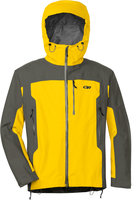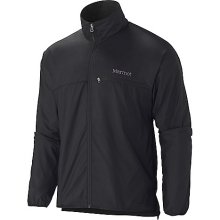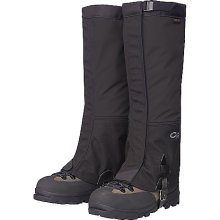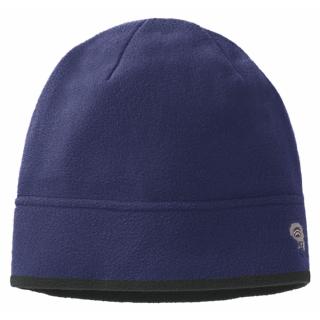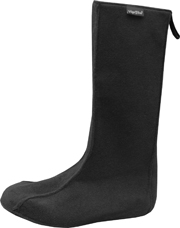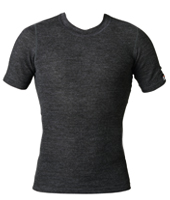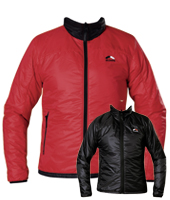A sample text widget
Etiam pulvinar consectetur dolor sed malesuada. Ut convallis
euismod dolor nec pretium. Nunc ut tristique massa.
Nam sodales mi vitae dolor ullamcorper et vulputate enim accumsan.
Morbi orci magna, tincidunt vitae molestie nec, molestie at mi. Nulla nulla lorem,
suscipit in posuere in, interdum non magna.
|
Just for the heck of it, I thought it’d be neat to rate all the races I’ve done – very subjectively – according to a few criteria. Feel free to agree or disagree (but please say why) and comment – or add your own races.
My ranking system:
Physical difficulty: how hard is this race in how much energy and effort does one have to expend to finish it? Though subjective, my ratings are – not surprisingly – fairly correlated with winning times, at least for races that had some top runners.
Finishing difficulty: how difficult is this race to finish in the allotted time? This really is the question – how much time do you have. Again, fairly correlated with overall finishing percentage, though some races have more rookies while others only allow seasoned runners.
Fun: how much fun is it overall? Very subjective. I like rugged crazy stuff, hanging with fun people, unusual adventures.
Scenery: how beautiful is it? This is of course highly subjective, but dings will be given for road sections, loops, etc.
The races are listed in the order in which I’ve done them – NOT in a ranking order. Scales are open-ended with 1 being the lowest. Of course everything is relative. Also it’s surprisingly difficult to keep rankings straight over so many races, so I might make some adjustments later …
Cascade Crest Classic
2005 course. My first, and of course that makes it special. It’s a “classic” with a large variety of different terrain, good challenges, overall a great mix of stuff. It’s a great race for a first 100, or to do at any time. Highly recommended.
Physical difficulty: 5
Around 20k ft climbing, minor elevation – difficult for sure. Some difficult trail sections, nothing too tedious though. I’m using this to set the scale for a moderately difficult hundred. From what people tell me it’s a bit harder than Western States, for reference.
Finishing difficulty: 5
32 hours is generous. Finishing rates hover around 70%
Scenery: 8
The Cascades are gorgeous, and you get great views, little road/civilization. Very beautiful. Some fire roads though.
Fun: 7
This race has been around, the aid stations have character, the course itself has a lot of special little treats: the trail from hell, the cross-country section”, the rope … and lots of good singletrack.
Bear
My second hundred – a very low-key event in a beautiful setting. The first year my race number was hand-written on the back of an old marathon race number!
Physical difficulty: 7
More climbing than CCC and higher elevation, variable weather, it’s colder at night – this race is by no means easy.
Finishing difficulty: 5
You have plenty of time, and good aid station support.
Scenery: 8
This one was difficult. While the views of the Wasatch mountains and the lake are incredible, there’s a lot of fire road, which takes a bit away from it. Somehow the 2005 course seemed more scenic to me, though the descent down to Bear Lake is nothing short of breathtaking (also because it’s hella steep). The fall colors make this a very special course as well.
Fun: 106
It’s a difficult race with some serious challenges – temps in the 20s at night, steep ascents and descents. I am very bummed Leland’s ledge – a crazy but fun cross-country section – is gone, which would have bumped the fun factor up +2. Point to point is awesome, but the organization at the finish means if you don’t have anyone pick you up, you wait for hours … though you get to chat with fellow racers! It was also my first date with Jill, which is a +100!!!
San Diego
2008 course. 2010+ is different.
Physical difficulty: 3
“Only” about 12k ft of climbing, good runnable trails, usually pretty predictable weather.
Finishing difficulty: 3
Plenty of time. Lots of rookies do this race, which explains the lower finisher rate.
Scenery: 5
The desert is sure beautiful, though not very mountainous and just comparing to Cascade Crest for example not quite as exciting. However, it IS remote. The original course up to ’06 had more interesting views of the desert as far as I recall.
Fun: 5
It’s got good friends and great aid stations. 2008 had two loops, which is a bit arduous, but the current course looks like a bit of a gordian knot to me, with some out and back, but overall less repetition, so it’s probably gonna be a 6 at least. The past few years the weather at the finish was so horrid (extremely windy) that no one stuck around, which was sort of a bummer.
Massanutten
I presume you may love it or hate it. But most people I know sort of hate it. Why? Goddamn rocks. Ironically it was probably one of the best races I’ve had, with a great group of runners which inspired me to a good performance. The people are as fun as the course is terrible. Somehow I’ve never had any desire to go back simply because the course is not good for the ankles and it’s a long way from the west coast.
Physical difficulty: 6
Not too much climbing, not at altitude. It can be hot, which makes this hard. The major issue in my view is the atrocious footing and the painfully sharp rocks. It’s really more tedious than hard, and if you resign yourself to walk the thing, it’s not all that bad.
Finishing difficulty: 5
36 hours makes up for anything but the possibility of injury. That said, even the famous Hans Dieter Weisshaar sprained his ankle quite badly the year I ran it.
Scenery: 2
Mostly in woods, and compared to the Cascades for example it’s just not as exciting. That’s not to say it’s not pretty.
Fun: 5
The aid station people are awesome. The runners are fun – a very different crowd from the west coast folks, especially Gary Knipling of course, quite the character! But those rocks … the running is tedious. It’s a 10 for the people and a 0 for the course. Sorry.
Tahoe Rim Trail
2007 course. The current course has added some significant climbing, making this harder. Parts of the course are deceptively runnable, making it oh so easy to feel like an old man at mile 50 … which is what happened to me.
Physical difficulty: 6
Even though the ’07 course didn’t have much climbing (I think less than 18k ft) and very runnable trails, the relatively high average elevation got to me – this was hard, and mile 50 felt like mile 80 to me. The current course is probably a bit harder.
Finishing difficulty: 5
The time limit was fairly generous, though recent finisher rates were below 60%, probably a combination of heat, altitude and some killer climbs and the oh so easy possibility to cut it short at mile 50.
Scenery: 8
It’s Tahoe, duh! Dings for two loops and some less scenic sections (like the red house loop), still it gets very high marks.
Fun: 5
The two loop format makes this hard, and the finish line didn’t invite any lingering though the pre-race setting was fun. It’s a great group of people, though and an awesome race.
Wasatch Front
Another classic. The tagline “the hardest race you’ll ever love” is not correct, but it’s a good race.
Physical difficulty: 9
There’s a LOT of climbing. Elevations are high enough to matter. Hot in the day, cold at night, variable weather.
Finishing difficulty: 5
The time limit seems sufficient. It’s hard but if you keep truckin .. just get out of Brighton store, the place people are most likely to drop, because it’s oh so cold outside and it’s oh so cozy in there. Get out!
Scenery: 8
Great views of the Wasatch mountains, it’s a gorgeous area. Point to point and remote.
Fun: 6
This race had a great finish area, where people could hang out and have fun! The race support is also awesome, of course – and it’s a beautiful and challenging course. What else would one want? No lottery, yeah.
HURT
One of my all-time favorites. I finally got my 500 mile jacket (with 560 official miles)!
Physical difficulty: 12 – While not at altitude, the very challenging footing, together with long darkness, lots of climbing and usual humid warm weather make this a significant effort. In a good run I am still slower here than I was at Wasatch when I was sick for a third of the race. In a good year, it’s maybe a 10, but in a bad year it’s more like a 14 – in slick conditions it can be a real struggle to finish.
Finishing difficulty: 16
This race is probably – along with Plain – THE hardest to finish (of the ones I’ve done). Depending on conditions, rates range from 50% down to 20%. There’s simply not enough time. Some say it’s the loops or the 100k option (which no longer exists) but this not the main reason – it can be very very hard.
Scenery: 8
While there are loops, it is a very unique course. The Hawaiian mountains are incredible and there’s no other hundred (I know of yet) in such a tropical environment. The night views are amazing. It’s simply so different from all the other mountainous races that I find it deserves a high ranking.
Fun: 10
The loops and out and back sections help here, you get to see everyone, it’s a very tight-knit group, it’s super-hard and you probably will be ridiculed, despite your feet looking like raw hamburgers. Sounds like fun to me!
Headlands
My home course! It’s a wonderful little race set up by awesome people in one of the most awesome areas I know – the gorgeous Marin headlands.
Physical difficulty: 4
It’s got some killer climbs, but the trails are all quite easy. If there were rain, it would probably creep up, because those trails can become pretty nasty …
Finishing difficulty: 4
Fair amount of time to finish.
Scenery: 7
The only ding here is for the loops. The course omit gems like Stinson Beach and Mt. Tam, though those were inaccessible to races for a while and make organization a lot harder. But Pirate’s Cove, the Golden Gate, SF … pretty spectacular.
Fun: 10
Running with all my local friends? Can’t be beat.
Plain
After I finished CCC100, a guy named Tom Ripley was chatting with us and he mentioned I should do the Plain. “What’s that” I asked. He laughed “Just a little run with no aid and no course markings. Some years we have a finisher.”. “Haha” I said.
Now it ranks very close to the top of my list, only TDG can displace it because of scheduling. If I had to pick, White Mountains might be higher, but that’s a totally different challenge.
Physical difficulty: 12
There are a few things that make Plain hard. The course itself is moderately difficult – ~20k ft climbing, can be hot, some cold at night, mostly good trails except for some very rutted incredibly dusty moto trails. But having to haul all your food, carrying a lot of water makes this simply hard. There are no comfort foods, no hot soup. Also, the course is long by 6 or so miles. Course finding is easy, though unnerving as there are no reassurances except for SAR checkpoints every ~20 miles. Oh, and those guys will gladly let you walk the wrong way. They’ll just come looking for you …
Finishing difficulty: 15
Now that more people have done it, and more information is available, it’s somewhat easier to know where water is etc. But still, you have to have your act way more together than at a normally supported race – a small mistake can cost you your finish. Thus finishing rates are low, and it is a formidable challenge. The time it takes to gather water, haul your gear, and the fact the course is a bit long makes the 36 hours fairly tight.
Scenery: 10
There are some incredible views to be had, raging wild rivers, creeks, expansive views of the Cascades, and except for start/finish no house in sight. One minor paved section, though it seems like a road in the middle of nowhere.
Fun: 10
This is a wild adventure! You meet crazy folks, and the feeling of being out there on your own devices makes this race unlike any other. It may not be your cup of tea, but it’s mine. This kind of “oh shit, what did I sign up for” feeling … priceless!
Javelina Jundred
Usually my end of year run if I’m in decent injury-free running shape!
Physical difficulty: 2
This is a shortish loop with lots of aid, gentle if at times a little sandy trails, maybe 5k climbing altogether. The possible heat and complete lack of shade does make it a challenge though.
Finishing difficulty: 2
Even if the heat gets you, it’s not really hard to finish this in 30 hours – relatively speaking. Still, the course has a low finisher rate because there are a lot of rookies, and a lot of people go out too fast.
Scenery: 4
The loop gets a bit old, though the desert views are quite beautiful, and the night is thanks to cloudless skies a treat in itself.
Fun: 8
The “washing machine” format makes it extremely easy to keep track of all racers. If you have friends there, it’s a blast. The costume contest adds flavor to it, and everyone is very laid back. It’s pretty much a big party in the desert. Also you do get to witness some epic meltdowns in some of the runners, not that that’s in any way fun, you know.
Coyote 2 Moon
Warning: I’ve seen the RD of this race in a full-body cow costume on the course. Enter at your own risk!
Physical difficulty: 10
I think this is harder than Wasatch despite less climbing because you do two nights, and the weather is pretty crazy. It can be either hot in the day and freezing cold at night, or goddamn cold and rainy in the day and holy crap cold at night.
Finishing difficulty: 5-10
This is one of the fun parts of this race. The RD will put you in a start group that should make it equally hard for everyone. Depending on how lazy he thinks you are, you gotta haul! The second time I did it I was in a group that had a cut-off one hour less than my previous year’s finishing time.
Scenery: 7
The course is actually surprisingly beautiful. I thought I knew that general topography, but it’s definitely got some excellent hills with a surprising remoteness, and some very pretty valleys and canyons.
Fun: 9
This race IS all about fun. On the runner’s expense. You get bonus minutes for eating “paté” (aka catfood) or drinking Whisky or eating oysters. Being ill-tempered and whiny will get you boner minutes. It’s a really fun atmosphere, and you have a chance to meet up later in the race with other faster and slower racers due to the staggered start.
Hardrock
Ironically Hardrock was the first hundred I’ve ever heard of (from Chuck Wilson) and for a good reason it’s one of the most sought after races in Northern America. Of course that’s also the reason I only got in once for six applications – because people always want to go back.
Physical difficulty: 17
Wow I pulled that number out of nowhere, so let me explain: it’s got a lot of climbing. It’s got an average elevation of ~11k, and tops out at 14k ft. It’s steep. It has some rugged trails. It is very demanding.
Finishing difficulty: 7
Despite the fact it’s very difficult, and despite the most strict qualification – there’s simply a lot of time to finish this, and a lot of people can finish this who have no chance at HURT. You can hike this comfortably without issues. Course finding can be challenging and requires you to pay serious attention, the markers are sparse and not always obvious. Weather can be life-threatening as well.
Scenery: 20
It’s THAT beautiful. Just look at the pictures.
Fun: 14
Since people usually acclimate for a while in Silverton, it’s an event like few others. Participating in course marking or scouting with fellow runners makes it much more likely you have a great time with old and new friends. The whole race is quite the production.
Bighorn
Physical difficulty: 8
There isn’t all too much climbing, though mud and elevation make this quite challenging. It can also be quite hot during the day.
Finishing difficulty: 7
It seems like the time limit is reasonably generous, though often finisher rates are lacking – the combination of everything makes this harder than it should be looking at the stats alone.
Scenery: 15
You start out into an incredible canyon next to a raging wild river, this is simply an amazing area. Some people like this better than Hardrock even, though I love alpine views too much. Still, it left me in awe, and I would say it’s an absolute must-do race.
Fun: 10
Out and back is a fun format to meet your fellow runners at least once, great aid stations, excellent pre and post race activities. Really there’s nothing not to like.
Swan Crest
The Swan Crest is a very small race and probably will only get smaller, unfortunately. It’s wild and crazy. You have to carry bear spray. And watch a bear video.
Physical difficulty: 11
There are very few aid stations and there’s a lot of climbing – around 24k. Trails are partially very rugged – one section of avalanche debris was extremely challenging (though not usually part of the course), and one poorly maintained section kept me wondering if I was off-course.
Finishing difficulty: 11
Definitely this race is a post-graduate race. Even though there are aid stations, the course markings are very sparse without reassurance markers and overall this is a very rugged race. If you expect to be pampered, stay home. Some people expressed criticism about the organization, which I reject outright – I thought it was perfectly organized – and as advertised.
Scenery: 14
This area in Montana is very beautiful, with expansive views, trails on knife ridges, just amazing. Some road sections and the lack of a proper wild river (though the crossing of the Quintonkin added fun) puts this maybe a bit below Bighorn (sorry Danni!!!!) but not by much.
Fun: 110
I am very biased on this one. I met Jill there (+100, of course). I went with my best friend Steve, and we had a generally awesome time. The finish venue is great since we had cabins right at the finish.
Tor Des Geants
This is the big one (for now). 200 miles. 80000ft of climbing. 24 mountain passes. Everyone but you wears Hoka One One’s, and guess what, you wish you had them, too. Because your feet hurt. And yes, I got a pair now.
Physical difficulty: 50
This race is hard. Somehow adding those 10k ft of climbing per 100 miles compared to Hardrock makes it just all the much harder – even without the altitude (though it does hit 11000ft – with a low point of 1000ft on the course). I felt the first 100 miles were much more difficult than Hardrock. The second ones would have been more difficult on fresh legs. They’re extremely difficult on tired legs. Trails are mostly runnable, though rocky and some parts are scree and boulder fields that are fairly challenging.
Finishing difficulty: 15
Although the race is super-hard, there is ample time and great support. Injury is probably the biggest enemy, but the medics are the best I’ve seen in terms of foot care and such. Accordingly, it’s not necessarily the fitter people who are more likely to finish.
Scenery: 30
Call me biased, but the Mont Blanc Massif (and Alps in general) has some of the world’s most beautiful mountains outside the Himalayas. I think they’re much more rugged and crazy looking than the San Juans, and the variety on the course is actually fairly big – historic villages, lush valleys, rugged mountain passes.
Fun: 20
It’s hard to call this race “fun” because it’s in a way so epic. Being completely sleep-deprived (which I did on purpose) led to some interesting effects, the people are awesome, it’s long enough you really feel like you’re in a different world. The only downside is that I should have learned Italian, because most people don’t speak english. But because of that I got to spend hours with one of the world’s best pro climbers!
Susitna
I had long been avoiding Susitna because I always thought I didn’t deal with cold very well and was afraid of frostbite and such. Turns out I was wrong – not only that, but I also got inexplicably hooked on winter racing. It’s hard to explain the fascination that an extremely remote trail on a frozen river somewhere in the wilderness at -20°F has, but I presume you either love it or hate it.
Physical difficulty: 14
My buddy Jamshid claims this race is so easy, but he’s full of crap on this one. Yes it’s basically flat. But consider this: you’re pulling 25-35lbs of crap on a sled. You’re running/walking on a surface that at best has the consistency of wet sand, often powdery. It’s very tiring, and very tough. Moreover, winter races have wildly varying conditions – it can be beautifully packed and easy (though I suspect it never is really that easy for runners) or – with fresh snow or a melt – a horrible postholing exercise. Also aid stations are 20 miles apart – so you gotta be prepared. Also if you have the opportunity to train a lot on snow, this is probably a bit easier than my ranking would suggest – but I found it to be quite slow going!
Finishing difficulty: 6
You got 48 hours, and that’s really quite a lot. But, you are more likely to develop issues, and if you get frostbite, you’re out (if you know what’s good for you). I did not factor into this the required learning curve – if you don’t have your gear properly set up, you really run a high risk of injury up to losing digits!
Scenery: 10
You may agree or disagree, but there’s something magical about a winter landscape. The Su gets some dings for too much snowmobile traffic and not enough hills to really take in the scenery. But it’s unlike anything I’ve seen.
Fun: 110
Another one of the +100s … Jill’s first 100 on foot 🙂 Even so, it’s a very curious prep because your gear is so much more complicated, which makes this a unique event – like a multiday stage race in some ways.
White Mountains
This might just be my favorite 100 miler!
A fairly new and very small winter hundred just north of Fairbanks. It’s very remote. Very very remote. Even though the are trails for public recreational use (all we saw were some dog mushers), Alaskans have a bit of a different notion of what “recreational” means.
Physical difficulty: 15
This race adds a few things to Susitna: steep climbs and overflow/glare ice! This race has substantially more climbing than Susitna, a lot of it on the last few miles. The trail conditions were generally worse which was due to some snow falling, and it’s likely that you have to deal with lots of icy overflow, some of it under some water. It’s a fairly serious undertaking.
Finishing difficulty: 5
The time limit of 60 hours is designed for really bad conditions – so under “normal” conditions, it’s far more than enough. Again, this does not factor in the incredible amount of preparation and learning you have to do before you should undertake anything like this.
Scenery: 15
It’s very hard to compare this with other mountainous races. This race has incredible views unlike anything you’ll see in a mountainous race, and there’s enough hills you actually get to see a lot of the surrounding areas. You have a good chance to see northern lights as well …
Fun: 11
This race is really family style – so much so, I stayed in the RD’s house along with some other racers. It’s a very tight knit group, and a great atmosphere.
Looks like I’ll have some downtime for a month or two – I had some acute achilles pain in the WM100, and it seems it’s an actual injury to the tendon – an MRI will show more. It’s painless unless I do too much biking or uphill running so far, so I’m hopeful this is a very small injury and will resolve itself within a few weeks of patient recovery – but clearly, this is one of the things that one absolutely cannot mess around with. Especially since I’ve got plans. Great plans.
SBER100 is definitely out, probably Ohlone 50k, and possibly (but hopefully not) San Diego 100. The first real goal is to run Tahoe Rim Trail 100 with Jill. Her first trail 100 – very hard, very beautiful. The new course has some killer climbs, but Jill is good at those, I think she’ll do great.
Capitol Forest 100 is just a fun little ride for Jill, but will be my first bike 100! If there’s any doubt about my achilles (or knees for that matter) at that point, I’ll probably opt to chicken out, but hopefully I’ll be well recovered by then and have a ton of fun on some awesome singletrack. My friend Roger is the RD, and he’s Swiss, so you bet this will be the best organized race ever.
Then, there’s the first big one – Tor Des Geants – again. 200 miles, 80000 ft of climbing, and I just have the feeling we won’t be as lucky with the weather this time. Again my strategy will be to go for 100 miles on no sleep, then sleep as little as needed. Foolish, yes, but intense and fun.
After that, we’ll strap on our packs and prepare for Racing the Planet Nepal – with our friends Martina, Steve and Chuck! The RTP races always provide unique experiences (again this year they arranged for us to visit some normally “off-limits” areas) and though overall maybe not as difficult as a solid 100 miler they can have some formidably difficult aspects.
But the real big goal is the Iditarod Trail Invitational 350 in 2012. This is another level of difficulty altogether. While there’s much less climbing than at TDG, this race is much more extreme. Temperatures ranging from 20°F to -40°F are possible, trail finding is up to you (and not always trivial), overflow is possible, one has to be prepared for storms, breaking through ice, only six checkpoints with distances of up to 90 miles between aid – all the while pulling a 40lbs sled over a surface that in the best case is like wet sand … And if I can finish this race, the full 1000-mile option becomes available. Preparing for this race will be epic by itself …
But for now, back to recovering … recovering … damn this is boring … recovering … sigh … are we there yet? … recovering …
As it turns out, winter racing is a serious affair if you want to keep your toes and such. Having your gear dialed in, and knowing how to use it, is very important. Here’s a few things I learned, and items I like to use … and this is really not even a remotely complete list of the stuff you really need (or should be thinking about needing at least) for a good winter adventure …
Note that I’m a pack-rat and also not exactly the most experienced winter racer, so you should by no means assume this is a list of any authority. It’s just supposed to give you an idea what worked for me and what didn’t … so far. I’ve got a lot more to dial in, and I think I could go much lighter if I really knew what I was doing …
These are some very bad-ass mittens, and easily my all-time favorite clothing item. They are extremely warm, based on the vapor barrier system, and extremely versatile (I did some research and those do seem like some of the best mittens one can buy, and I wasn’t disappointed). A system of a the mitten shell and various liners worked wonders for me. Usually I start out with the shells (which are extremely thin) dangling from my wrists and gloves. When my fingers get cold, I can slip on the shells. When the temps drop, you can switch from gloves to fleece mittens (Generally I find if things get frosty, gloves make my hands cold). For really low temperatures I use the mid-weight mitten liners from RBH (the hybrid liner) which I ordered with the mitten and which are way hot, and easily kept my hands warm in -20F – I expect to have no problems even much lower. One thing I did is use thin gloves as a third layer. While they don’t add any warmth, they are very useful if you need to take your hands out to do things – a thin glove can extend the time you can operate your fingers considerably (and when it’s very cold, that time can be in the range of minutes). If you’re expecting it to be really crazy cold, the altitude liner from RBH should do the trick. I always bring a number of hand layers, they are light, and it’s essential you have a dry set.
Honorable mention: A nice midweight fleece mitt is the OR PL 400 .
Vapor barrier clothing is an interesting phenomenon. Some love it, some hate it. It works for mittens easily and also for socks. I have a VB shirt, which is a two-edged sword. It is warm, but it’s not fun when it’s wet. You’ll feel cold, but not REALLY cold – it’s uncomfortable but presumably safer because you don’t mess up your insulation layers. I still need to experiment more with those. The RBH website has an explanation of the principles behind VB clothing. It requires a good amount of discipline to use this system optimally.
Outdoor experts like Dave Chenault will call bullshit on a waterproof breathable shell in the cold, and to a certain extent that’s right: if it’s cold, breathing doesn’t work well. You always end up with a layer of ice inside your jacket (if not on a lower layer). However, this jacket still has a lot of good going for it:
- In Alaska, especially for multiday adventures, you can hit a wide variety of weather. When it gets warmish, snow or (gasp) rain can happen. This shell is stormproof with sealed everything, and absolutely windproof (which is a feature of the material, GoreTex ProShell).
- It has a good set of pockets which work well with a belt for a sled, since they’re designed to be used with climbing harnesses – same thing. Hold a LOT of stuff. Well placed.
- It has a DOUBLE main zipper (my other Arcteryx jacket doesn’t – booo!). When it’s cold and you want to vent, it’s better to vent down there but keep your throat covered – at least that’s what I feel.
- The side vents go all the way to the hem, so you can use the jacket as a poncho. That rocks! Pit zips don’t usually work well – pain in the ass to operate. These zips rock.
- Adjustability all over, as one would expect – hem, hood. The hood, while helmet-sized, can still be used without and you get a nice high neck, making for some seriously stormproof or wind/cold-fighting prowess.
This is my go-to jacket when the going gets tough. Don’t expect too much in the way of breathability particularly in the cold, but the easy venting more than makes up for that. Why spend $400 for a plastic poncho then, you ask? Because if you look hard and are patient, you may be able to snap one up for <$200, at which point it looks like a good deal – you just don’t get that level of functionality in a simple shell jacket.
Pants: North Face windstopper tights
I got a closeout model. They’re Gore Windstopper fabric pants, and I have to say I’m a big fan of that material. They operate well in an enormous range of temperatures for me – from 40ºF to -20ºF with a 20mph wind (ok they weren’t quite adequate for that, but they kept me going nonetheless without any frost burns of any kind).
In the winter, the wind is your enemy. Not only does it suck your energy away, but it can make dressing a real pain, since often the wind changes much more significantly and quickly than the actual temps. Having a windblocker lets you not only stay warm, but, if properly layered, you don’t have to adjust as much when the wind picks up. This shirt is light, has a relaxed fit which I really like, and feels great with a lightweight brushed fleece inner layer. Having a layer with a full zipper allows for better venting and access if you put your camelback underneath.
I’ve had good experiences with these – they are waterproof (Gore-Tex, see disclaimer above …), rocksolid, high and keep your legs and feet happy. I believe that Gaiters like these help a lot keeping your toes warm, because they keep your lower legs and ankles warm due to full wind protection (and simply adding a layer there). All major serious Gaiters probably mostly work well, you just should make sure you get the right size and try them out. I would pick high gaiters for longer races.
For $14 at Sierra Trading Post this may be the best bang for the buck on this list. It’s warm, windstopper fabric rules, and it’s soft and works well even with wet hair. Very versatile, and it allows you to use the non-windproof fleece balaclava effectively via layering. I also like the peruvian style hats, though they make me sort of deaf.
This one is surprising. It’s super-comfy, holds up well when accumulating moisture, dries quickly and is very warm. Combined with a windstopper cap or by using the hood on my jacket, it gets me very far in the cold. This balaclava also has an adjustable fit which is useful. I’ve also used:
- Thin under armor balaclava: nice, but once it ices up, restricts your breathing! Doesn’t work when it’s cold. It would seem that’d be the problem with any tightly woven fabric.
- OR Windstopper Gorilla Clava: This is a monster. It has a neat multi-deachable nose and mouthpiece. While it may still find use in harshest conditions particularly with high winds, windstopper material tends to harden up a lot when it gets wet, and the velcro used to attach those pieces makes it hard to really get a good fit – especially when it’s cold and you wear mittens. Still, for very long races, a windblocking balaclava will be part of my gear as well.
But in the end, this pretty cheapo and fairly simple balaclava seems the best to me.
Note: I also have a Turtle Fur fleece neck gaiter (basically a fleece bandanna) and that thing is also seriously awesome when it gets frigid.
These are some serious vapor barrier socks. They’re quite thick, with a fleece insulation layer on the outside of the barrier, and very warm. The big advantage of these over regular fleece socks, especially when used with waterproof shoes that basically don’t breathe, is that the insulation layer and the shoe stays dry – there’s nothing more of a downer than wet shoes. Use them with some liner socks that work well when wet (like Drymax socks) and add some hydropel and you have one possible system for warm feet. Note though that if your feet are warm depends on a lot of factors – core temp, how cold your legs are, how stiff and tight your shoes are etc.
This has been my favorite baselayer for a long time. It feels good when wet and dries very quickly. And it’s made in the Alps 🙂 I also like Craft midweight baselayers, they have similar properties.
Basically a placeholder for any lightweight primaloft jacket, though Skinfit does its version as usual very well, with a lightweight built-in hood. I also usually bring the Patagonia nano-puff, though the jacket is only marginally heavier and due to the full zip vastly more versatile. If I had to chose, I’d go with the jacket. As is well known, primaloft maintains some insulating properties when wet, as opposed to down, which makes this an important part of my gear list.
Bit on the pricy side, and slightly heavier compared to it’s small brother, the HP-10 (which outputs the same amount of light). This guy has a number of things going for it:
- Remote battery pack. Keep it warm, hell, put it down your pants. I won’t tell anybody. Even keeping it in the outside pocket of my shell I got 1 1/2 long nights of use out of 4AA batteries (but Energizer Lithiums only).
- Remote on/off/mode switch that has led’s. That one’s really awesome. Don’t fiddle with the lamp on your head, justclick those things. Sweet.
- Bomb-proof. It’s pretty heavy duty.
- Downside: cable mess. Especially when putting the battery pack in your jacket, it makes taking the jacket off a pain.
Also, don’t be a dummy like Steve and always take out the batteries or what I do put a small piece of paper or cardboard in the battery compartment preventing contact of the battery to avoid having the light turn itself on accidentally in your luggage. And then forget to test it before the race … oh Steve. Like a rookie. Honorable mention: Fenix HP-10 – my non-winter headlamp. Great output, great battery life, great price for the performance.
Whatever you bring, use lithium batteries. They’re pricey, but an added bonus is that they only weigh half as much as alkalines (for the AA Energizer version).
These things ROCK. Forget YakTraks – those are useless (fall of your shoes and don’t do well on ice). These things work great on ice, and you can run in them without any worry or issues. They’re not, however, snow traction devices. Ice and very hard-packed snow is the sweet spot. But they fit an enormous range of shoes securely – I was able to put my L size Katoolahs over my insulated size 14 baffin boots which are extremely big. I didn’t bring those for Susitna, since I knew there is no ice to speak of, but I had and used them in the White Mountains, and I used them a lot during training in snow – lifesaver when you hit glare ice.
Shoes: Blahblah GTX
Anyone recommending any specific shoe to you is a liar or dumb, and magazines reviewing shoes are just laughable – it’s just business. Shoes need to suit your foot, the way you run, etc. There are a few things I learned:
- Running shoes are sufficient to keep your feet warm IF you’re moving.
This is in stark contrast to biking, and I attribute this to the fact that your flexing your foot and using your toes to stabilize during running or walking actually entices enough circulation in your feet to keep them warm. Unless your shoes are wet, that is one of the major issues with cold feet, and you can have gigantic boots and still numb toes if there’s no circulation. Some people use light hiking shoes as well, with no problem. For long events, as added security, I will probably bring insulated overboots though. You just never know.
- Size up!
I usually size up one size for ultras, but for winter ultras I sized up two sizes. More important than anything is that your shoes are not tight, as any constriction in circulation will make your feet cold. No tight socks, and no overly tight lacing either. Adding sock layers, if they make your shoe tight, won’t do you any good.
- Gore-Tex works, sometimes
A Gore-Tex shoe is basically a lined rubber boot in effect. You probably won’t sweat quite as much, but there’s no escaping the fact that they’re just not breathable enough. They work really well in extreme cold, because your feet probably won’t sweat all that much. Protection from occasional overflow and melting ice at the checkpoints is really welcome here. However, they did pose a problem in warm temperatures for me – they got wet inside, and they will stay wet unless you take the time to dry them out. Vapor barrier works for that, but your feet will be wet. That’s something that can be dealt with (Hydropel), but it needs to be taken into account.
As for minimalist running shoes: obviously they don’t work in the cold, I presume even the craziest proponents of those shoes will realize that. But y’all know it’s just a fad, right? There are like a million reasons why it’s bullshit.
I haven’t really needed them yet, but they beat plastic bags for protection from overflow and running water. Put on the waders and strap on the Katoolahs and you’re secure, dry and worry-free. Plus they only weigh 9oz, which is a small penalty to pay to avoid potentially toe and race-threatening wet feet! Plus they’re waist-high, which, believe it or not, can be needed!
Down is the king of warmth. The Hyperion is Jill’s lightweight jacket and it’s wonderfully small, incredibly warm despite just 11oz of weight. I got the Helios, however it is too slim (and most importantly short) a cut – if you get one, order one size up from your normal size. I got the parka for colder and longer adventures and couldn’t really put it fully to the test yet , just as pre-/post-race clothing for White Mountains – however it is insanely warm and has great features:
- Detachable hood
- Cavernous exterior pockets with plenty of down just for the pockets
- Gigantic interior pockets that allow you to store multiple 1l-bottles in your jacket
- Extremely high quality down (875+ fill), and lots of it
The FF jackets are surprisingly not that expensive and I’d pick them over Patagonia or such any day, the Nunatak is made to order and definitely not cheap – but it’s a great piece of equipment, with every detail thought out. Plus the Nunatak is handmade in the USA (the FF ones are made in Canada).
During the Susitna, both Jill and I ended up wearing our FF jackets for parts of the run, and we were glad we had them …
THE lightest waterproof windproof breathable full-zip pant I could find. Actually the lightest full-zip pant altogether. Again with the breathability, but these are waterproof with waterproof zippers and sealed seams, reinforced in the seat and knee area, with extra zips to allow them to go over boots. Whatever you end up getting (since I gave mine to Jill I am using the cheaper heavier Marmot PreCip pants, which aren’t too bad either) the full zip is really important to me. You don’t want to take your shoes off to put on pants – ever. It’s come in handy in many races, not only winter ones. Also you can unzip to vent, another invaluable feature. Full zip rules.
 Far away view of the Wickersham wall. 800ft up in less than 1 mile on soft snow. “Fuck this! Who was this Wickersham anyways?”. Sweat is streaming down my shirt under my jacket. I briefly stagger, almost loose balance, pulled back by my anvil of a sled. “I feel a bit dizzy.”, Kevin says. “Didn’t they ever hear of goddamn switchbacks?”, I pant, “I mean … fuuuuck!”.
Earlier …
65 racers collect at the Wickersham Dome trailhead to participate in the White Mountains 100. About half are bikers, half skiers and then there are the crazy seven, the foot people, “walkers” as the local news article had called us. That term is a sad mix of insult (at least in a 100 miler) and omen, evoking visions of elderly with walking aids that reflect just how we would feel in a day or so, when we would be reduced to just that – walkers.
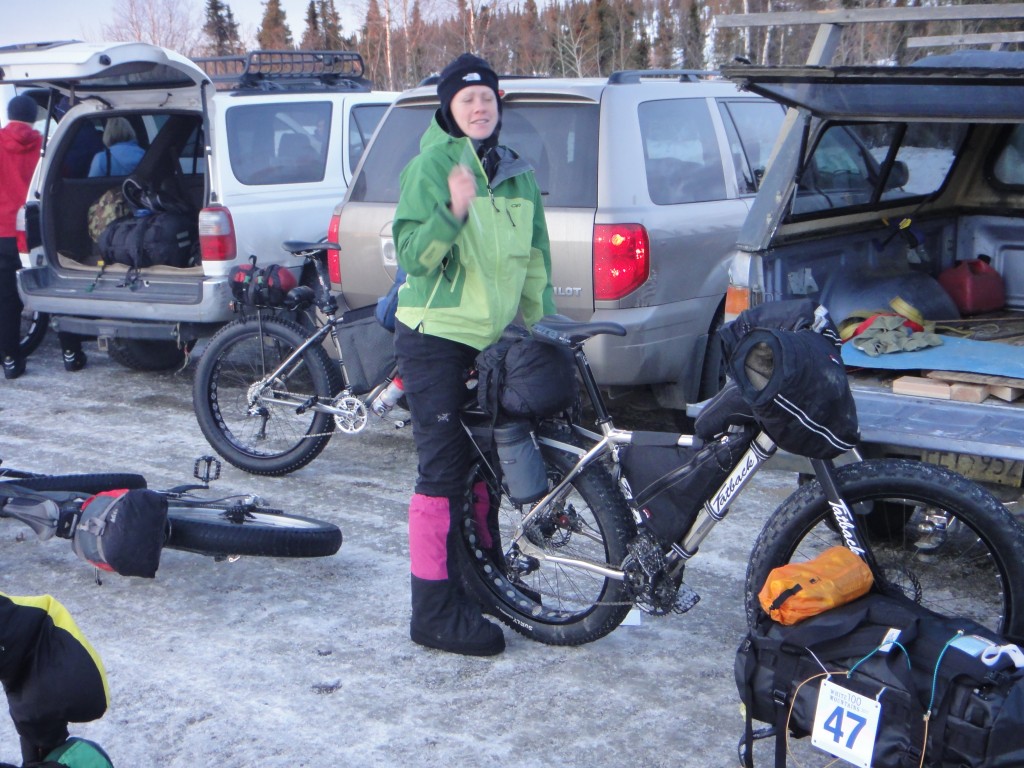 Jill not yet awake but stressed since it's only 15 minutes to the start and we're not ready. The dynamic among the groups is interesting. From what I can tell, Bikers are here to compete most and foremost with other bikers, and to make sure the skiers know their place. Skiers come here to race each other, upstage bikers and hope for soft trails that would give them the edge to do so. Both think walkers are crazy and stupid for choosing such a poor form of winter travel, but there is a spark of admiration, an acknowledgement that indeed, walking is the most pure, the hardest, the most painful, the most mentally challenging. We, on the other hand, simply enjoy the fact that we get the most fun per dollar of our entry fee. Twice as much, usually.
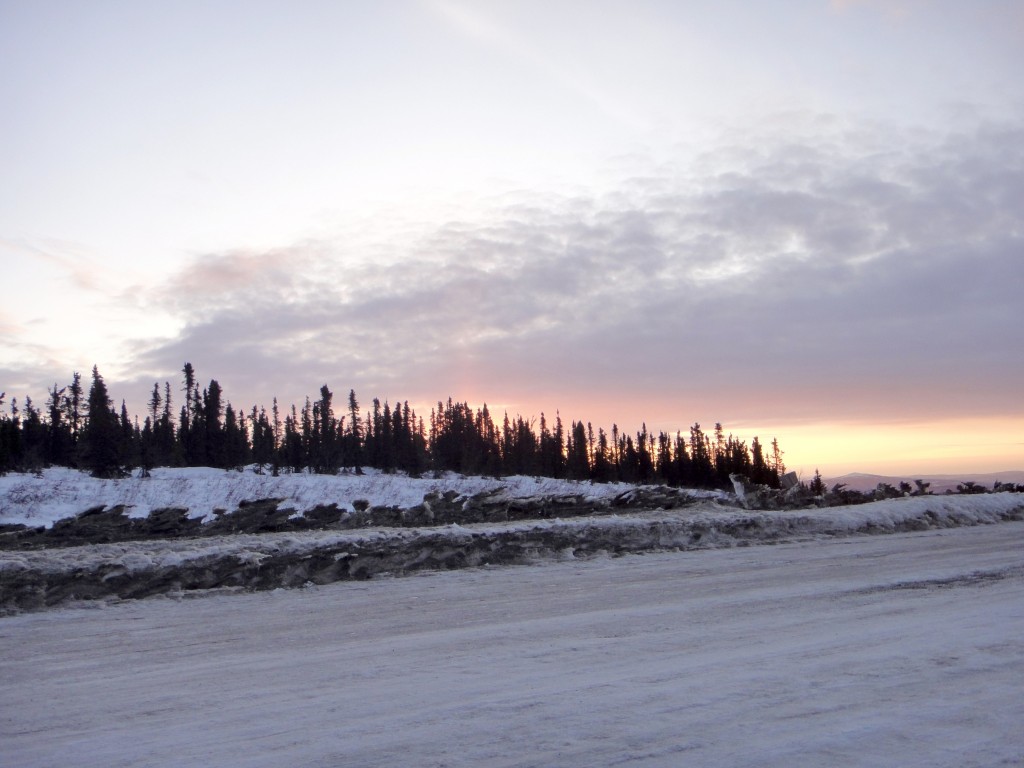 Sunrise at the Wickersham Dome Trailhead.  First Checkpoint! After missing the start by a few seconds, I fall into a comfortable uphill hike. The trails are good, hard and my sled glides well. Despite the early hour and a relatively high starting point at about 2200ft elevation, it is almost warm – probably already above 20°F. The sun and sky seem to indicate that it will be a beautiful day, at least for a while. After a mile or so, I catch up with Anne Ver Hoef, and we stick together, chatting and enjoying the wonderful scenery and trails. WM100 is significantly hillier than Susitna, making for more varied running and views. Despite feeling a bit under the weather, the first 17 miles go by fairly quickly, and I arrive at the first checkpoint in just 4 hours, better than I expected (it needs to be said that snow – even good trails – is simply a lot harder to run on than dirt and rock …). At the checkpoint I consume some mandatory Tang, which, as Jill told me, is an “Alaskan thing”, fuel up (somewhat) and continue on my way.
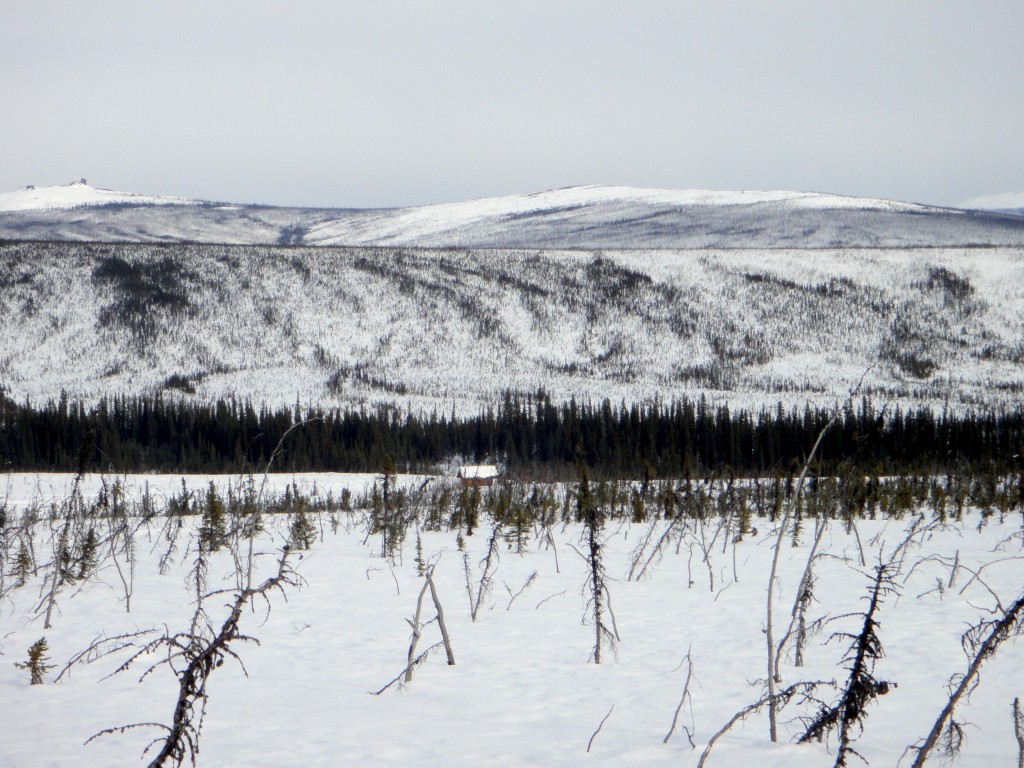 Cache Mountain Cabin! Most welcome after 37 miles on my feet ... Soon after the first checkpoint, the trails get softer and the running gets harder. Our merry band of walkers has long fallen back from everyone but the occasional skier or the bold but sadly misguided skinny-tire biker, and I keep leapfrogging various people. The weather is beautiful, the scenery breathtaking – the soft trails give me all the more reason to stop and snap pictures, or simply take in the remoteness of the course. I imagine we could just keep going across the Brooks Range which is of course not visible …
Going is tough and I am fairly glad when I finally arrive at the Cache Mountain Cabin. Trystan, the eventual foot winner, passes me shortly before the cabin, walking very efficiently – a good lesson to be learned. A group of walkers, along with a deliberately slow skier and a biker are there, and we all replenish on a big baked potatoe. One good thing about a strict race organizer and being one of the last is that you end up getting more food – they’re less likely to deny leftovers when you’re one of the last people out there. That said, I think food rations should be proportional to time on trail, and as such should be increasing. It all works out anyways, however I hope the RDs take note! 🙂
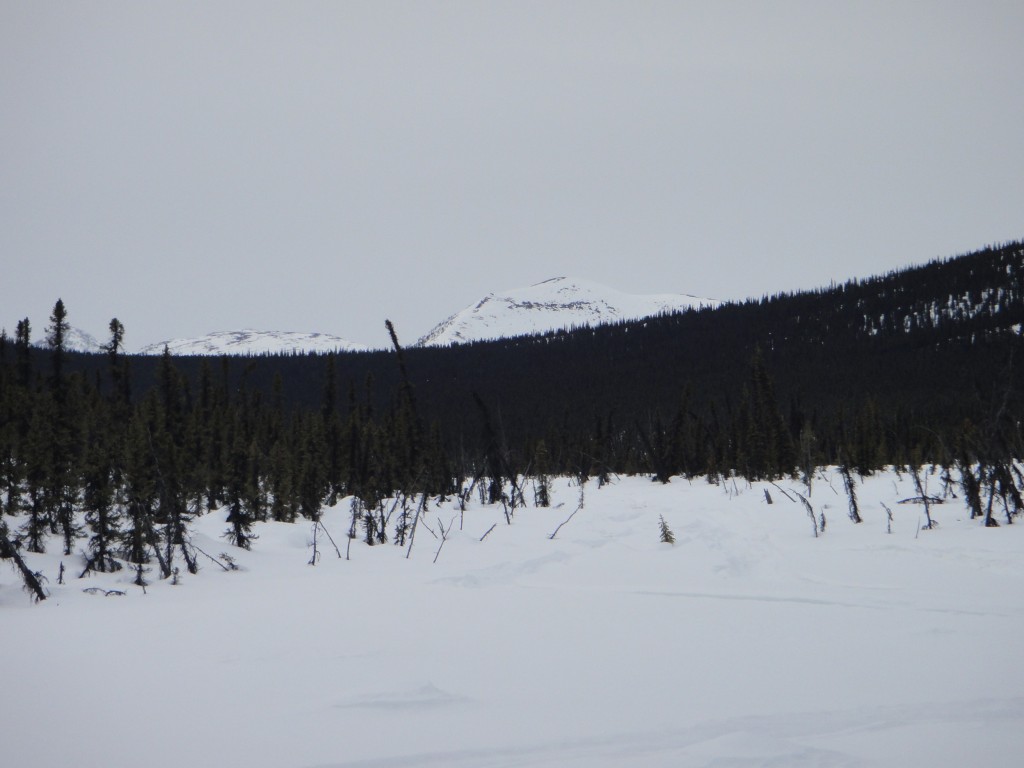 Guessing which one is Cache Mountain ... I leave the cabin toward the Cache Mountain Divide just a bit before dusk, and soon the light turns gloomy, clouds pull up and it starts to snow – not heavily but constantly. The temperatures are still warm, and there is a solid ~1800ft climb to the divide ahead. I like the gloomy atmosphere, somewhere in this barely touched wilderness, into the night … I have a moment of regret that I did not stick with my original plan to bike this, which would not only have been a lot faster and easier, but also would have given me the opportunity to share the views and experience with Jill. But I know that in the end, I would also feel sad not to have experienced this trail in the most basic and intimate way possible, alone, on foot, fighting for every yard …
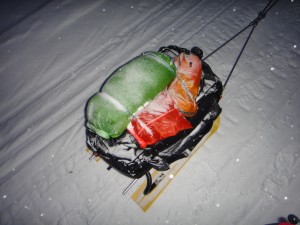 Uh-oh. As I climb to the divide, I can still see the tree-covered hills – I know the divide is just above treeline and that seems awfully far up … but before soon the trees thin out, and, now in more complete darkness, the trail levels out, until I see a strange snow sculpture that seems oddly out of place up here – the top of the divide. I take some time to take a photo and notice how much snow has accumulated on top of my sled. That’s gonna hurt later on …
 Not hallucinating. The drop down from the divide is fun, though it is dampened by generally soft trails. Still, it’s easier than going up, and soon I reach the famed ice lakes, a confluence of overflow in the narrow valley/canyon that accumulates a lot of ice, often with standing water on top, about a mile long. This time, there was very little water, and I simply strap on my beloved Katoolahs and enjoy the effortless running and walking. There are some areas of slush with unknown depth and I didn’t put on my waders, so I have to pick my way through the wide area of overflow, giving me at least a bit of excitement. Towards the end of the lakes I catch up with Kevin, an ultrarunner and Su veteran from Palmer, and we decide to move along together for a while. This stretch is 23 miles long, and some company is welcome for a change.
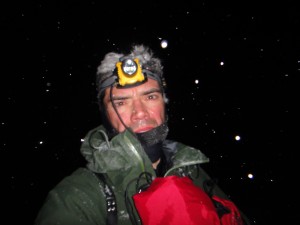 Serious business, being on top of a divide! Despite the expectation of an “easy downhill”, I find the remaining eight or so miles to the Windy Gap cabin more rolling – on soft trails, nothing is really easy. Windy Gap is hosted by the famed “Meatball Nazi” Dea, though this year the meager ration of three meatballs has been increased to five in an unparalleled act of generosity by Dea herself, falling a bit out of her historic role though. It is truly a royal meal, supplemented by Starbux via coffee and – naturally – a few cups of heavily concentrated Tang – or “Alaskan Ambrosia”, as I will think of it now. The generally warm temperatures make dressing fairly easy, though my feet and shoes are thorougly wet thanks to the Gore-Tex shoes. Unwisely I had not used Hydropel from the start, but ample application thereof sees to stave off the worst disaster for now. I decide to switch to a vapor barrier system for my feet, since my shoes are now so wet inside that they dampen the socks immediately. I don’t feel the need to dry out my shoes though (which would usually be a wise course of action), since the temperatures simply do not get low enough for this to become a problem. To my surprise I find a number of people sleeping in the cabin, all skiers who somehow are not aware that sleep is really just not a luxury you should afford yourself in such a short race. The cabin itself is extremely hot, almost sauna-like maybe in an attempt to duplicate Luce’s offering in the Su …
I leave Windy Gap about 15 minutes before Kevin for another 20 mile stretch. The first miles, still in the dark, are accompanied by an unusual tiredness on my part, and I find myself often closing my eyes and stepping off the trail (which can have some rather unpleasant knee-to-waist-deep surprises) or simply stopping, dozing off within seconds, just to be awoken by the sensation of my falling forward. Caffeine pills do not appear to help, and so I simply trudge along, slowly, expecting Kevin to catch up with me eventually. We’re now getting close to Beaver Creek, which, last year, had temperatures down to -25ºF – now, though it may be in the teens or at the worst single digits, with the occasional short stretch of some wind to add some windchill, this seems like a non-event, though it’s a very pretty trail. Soon dawn emerges and I find myself walking and shuffling alongside towering limestone formations, and occasionally I can see the mountains disappearing into the low cloud cover, a strange and eerie atmosphere! Despite some hurtiness in my feet I am taken by the scenery, and though there was of course no chance to see northern lights at night due to the clouds, I am taken. I wish this was a much longer race, and I could stop here for a while to bivy, just stay in this beautiful place – but alas, I have to move on.
 The morning reveals a different world ... 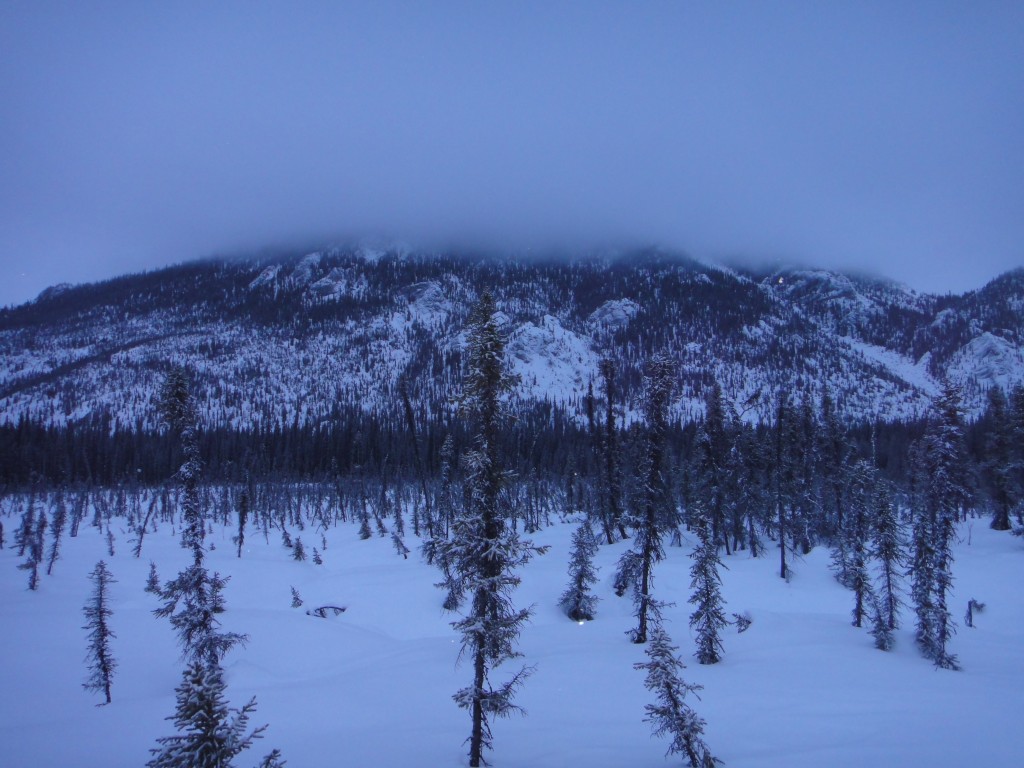 Absolute quiet. Soon I start to reach the wider valley and a trail intersection, with a mileage sign for the Borealis cabin, our next stop – 7.8 miles. I expect this to be a fairly flat and reasonably fast section, which is a robustly wrong assumption. Not only does the trail climb and roll quite a lot, it also turns out that the section is about 10 miles long – after about 7 I get increasingly frustrated and experience a little fit, when a skier passes me, breaking the crushing news that I’m really not as close as I thought to the cabin. Ironically the only thing that makes it hard is the mismatch of expectation, because what does it really matter … when I finally reach the Cabin, I am however simmered down enough to have a good time, with homemade bread and salami, more tang and fresh french press coffee! Kevin arrives just a minute behind me, and the last runner, Darren, also shows up, complaining about the sign. Darren seems to be a tad bit competitive, and the prospect of being the dead last runner out there flashes across my mind. Hydropel, socks and I’m out of there!
 That lil' wall don't scare me! The last 19 miles are thankfully split by a small checkpoint after 8 miles. It’s a fairly straight shot from here to the junction where the course joins the outbound route and backtracks the initial 6 miles. After about 2 miles I have a great view of the valley and look for the Wickersham wall. I scan the horizon, rejecting possible candidates, until I conclude that only that menacing looking white line on that high hill could be it. With now 10 miles to ponder both the prospect of finishing dead last, and having to drag my incredibly heavy sled up 800ft of soft snow, I can all but smile.
 Don't drink that. After a few miles Kevin catches up, and I propose a truce – walk in together. “That way at least none of us will finish last. To be honest, it’s self-serving – I think you’ve got more left than me.” I say – “Funny, I was thinking the same.” Kevin responds. The final miles have more occasional overflow than the earlier course, though none of it has more than half an inch of slush on top of it. Recent snowfall has made glare ice a non-issue, though every now and then I can see that we are walking on large slabs of angled ice, which had provided much excitement to the racers last year. Even now, walking over the short stretches of overflow reveals disconcerting sound of crackling ice and hollowness, and I move quickly. The last checkpoint arrives quickly and we linger briefly for a final infusion of Tang and candy, and we’re on our way to the famed obstacle – the wall.
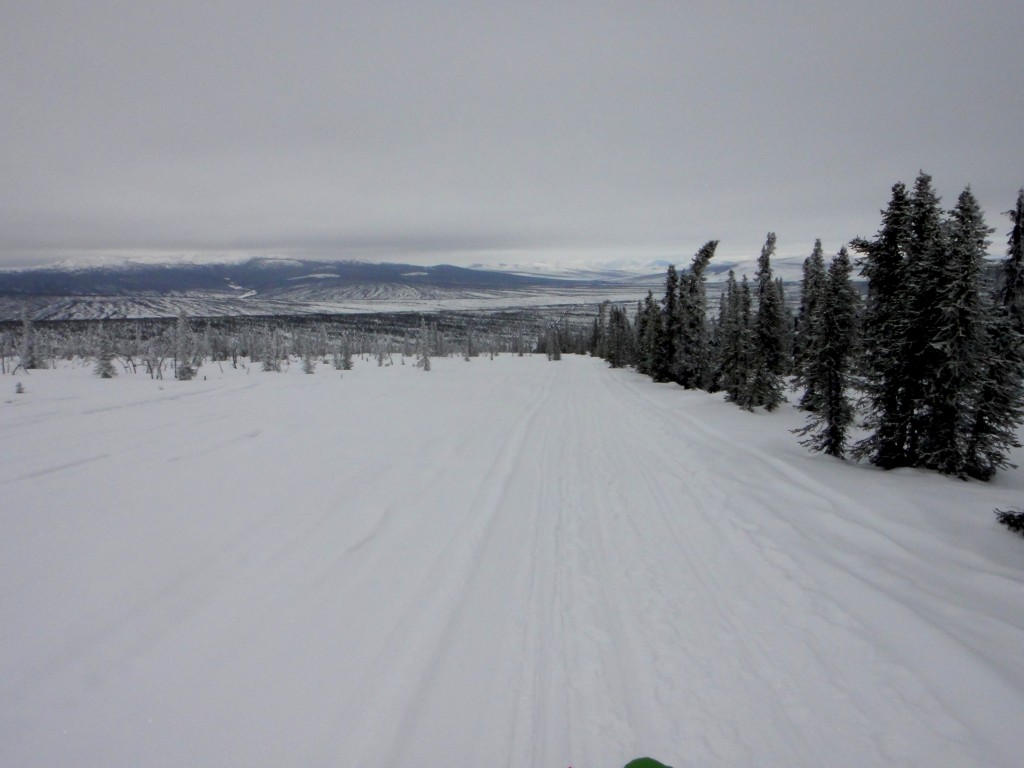 View back from the top of the Wickersham wall. 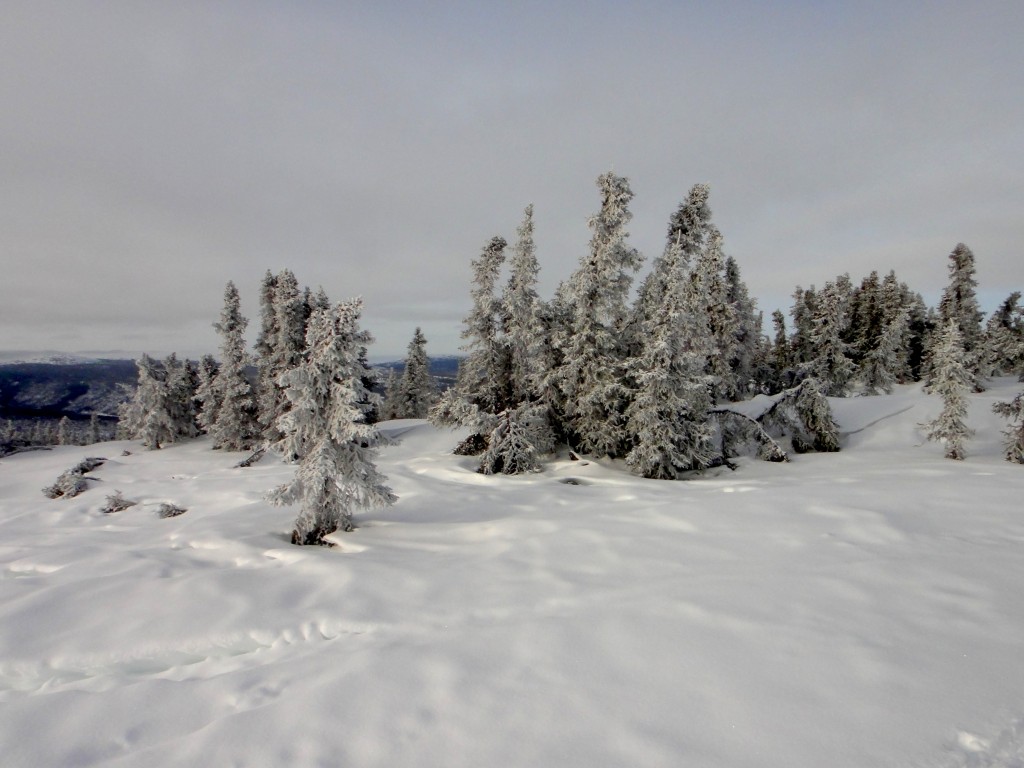 Fresh snow on the trees from that night. “This is it.” I say. The trail angles up. “This doesn’t look bad.” Kevin replies. “We’ll see.”. As we make our way up the wall, the trail reveals little crests, preceded by insultingly steep angles. I am using my poles, often they are the only thing preventing me from sliding down the trail. Traction is marginal, and often I have fight for balance. My sled has nicely iced skis with greatly reduced glide making things even better (I do not think of cleaning my skis until a few hours after the race ends …). My effort level is at the maximum, sweat is running down my shirt. “Wow, I’m soaked. We’ll have to haul ass after this hill or I’m gonna freeze to death!”. Kevin has other worries – he says he’s dizzy. Visions of Sisyphus or at least Egyptian slaves hauling rocks up pyramids (Yeah I am THAT hot) flash through my mind. Finally, we approach the crest. All I remember about the last 6 miles is that someone said it’s supposed to be a nice downhill to the finish at some point. Of course, as it turns out, that’s just the last mile. Up to there, the climbing continues on, more gradual, but continuously, only to be broken by a few short downhills.
Before the race I had joked with Jill that she should come meet me out on the trail on foot. I don’t really expect her to be there, actually I expect to have to bivy a bit until she can pick me up, but about 3.5 miles from the finish Jill comes towards us, much to my delight! It makes the final miles a lot more pleasant, though sadness sets in that it will be over, mixed with bursts of anger at the continuous uphill (“I don’t remember it went ALL UP at the end! WHAT?”) and worries about my achilles which started hurting, occasionally sharply, after the wall (one week later, it’s all back to normal – phew). Finally, we hit the last downhill and I run it down just to be done, wait a few seconds for Kevin to catch up and we are done! 35:41, 3rd place tie. One more runner will finish behind us, as well as one more skier.
So how does this race compare to Susitna? I would say:
- it’s a lot more remote
- it’s more challenging, with more variable conditions possible, though locals would probably tell you there’s more chance of very good trails due to low precipitation in that area. However, this year the trails were challenging for runners.
- it’s at least equally well organized, though you will see far fewer safety patrols, and far fewer people overall
- it’s a ton of fun, and the terrain is gorgeous
- it’s (even) more of a family affair
- course finding is all but trivial. between very few trails, fixed markers and signs, and some race markers it’s almost impossible to get lost
- It’s a serious race for people who know what they’re doing. There’s no mandatory gear, and you are expected to be able to take care of yourself. If you read the term “wet overflow” the first time in this report, you have a lot to learn before you should even think about signing up.
Chapter 3
Alexander Lake and back
I felt warm and more confident leaving Luce’s to make my way to the turnaround point. I looked forward to it, because Alexander Lake is a bit more than halfway, which would be a nice mental boost for me – all “downhill” from there on (yeah you gotta lie to yourself as an ultrarunner …)! My mode of running this race was to go a bit faster than Jill for a few minutes and then wait for her to catch up. It wasn’t terribly social, and I felt guilty about that, but at the same time talking was not possible anyways since you could rarely go side by side without one person having significantly worse footing. Also, I think Jill appreciated the quiet in some ways, as we moved through this bizarre landscape, both lost in our own thoughts, sensations and emotions, yet intensely together. The stop and go mode of walking was also somewhat easier than trying to go exactly Jill’s pace – it’s actually not that easy to really go slower than you usually do. Still, the interruption made it hard to find a good steady state, and I was surely as tired as Jill. At the same time I grew increasingly impressed by Jill’s ability to continue on, as this race was quite a lot harder than I anticipated.
We left Luce’s with renewed resolve and this time well dressed. The fierce winds had died down, and I soon was toasty warm. We followed the river futher but soon veered off onto a less well packed trail. Dragging our sleds became significantly harder … We made it off the river into a swampy wooded area. I told Jill that I estimated it would take us around five hours to make it to Alexander Lake, though secretly I hoped that would be a pessimistic estimate … it wasn’t. We were now deep in the night, and I couldn’t find my caffeine pills, and I was too lazy and tired (duh!) to look for them, so I carried on just on the coffee and Diet Pepsi’s we had at Luce’s. The trail veered through more swamps and odd looking woods with scraggly trees, and only rarely would we now hit a patch of trail where we moved well. The 12.5 miles seemed to take an eternity. My severe overdressing took its toll in me sweating a lot, though I did not feel chilled due to that. Finally we arrived at the cabin. Excited, I rushed ahead and dragged my sled up the ramp to the little hut and got my sleeping bag out of the sled to have it checked.
The hut reminded me of a small mountain hut in the alps, except after maybe some alpine tragedy had happened. People were passed out on various beds, chairs, couches and there was no place to sit. Jamshid was still there, having problems with his eyes. “No, don’t turn it on green” he said when the checker turned off his headlamp – with only white lighting modes. I sure hope he’s alright now, but he would finish the race strong long before us. Danni staggered into the cabin a bit later and without a word crawled, after her bag check, into said bag under the table of the checker.
As it turned out I had severely soaked my base layers including my primaloft jacket, which were dripping wet. What a dumb rookie mistake, and one that could have made my remaining race very uncomfortable, if not outright dangerous. Fortunately I had spare layers, and I completely changed my base and insulation layers, though wearing only about a third of what I had before to avoid the soaking. I planned on compensating with the better mittens instead, and maybe some chemical warmers if needed.
Due to the uncomfortable atmosphere we did not end up staying long, and that was just as well. When we left, I suggested to Jill we use the poles we bought to make our journey back easier – I had thought of it earlier but somehow we decided we’d wait until the return trip – not really for any good reason, but it goes to show how reluctant one gets to do the right thing just to keep going. Gripping anything tends to make your hands cold in these temperatures, but my RBH mittens did a great job of keeping me happy.
The return trip was just as long as the trip outwards except for the odd chirping of the poles as they hit the snow. Both Jill and I got very tired, as we approached dawn, and I staggered all over the trail. I still couldn’t find my caffeine, but Jill offered me some chocolate covered espresso beans which helped. She was also suffering from tiredness, but I tried to cheer her up and reassure her that she’d be like a spring chicken come sunlight. Just before we hit the river I carved “Jill rocks!” into a snowbank with my poles, which earned me a warm look and icy kiss, very much the highlight of the whole section.
 The undisputable ice-lash queen. Hot. Chapter 5
Flathorn Inbound
We arrived at Luce’s in the early morning. We were not particularly cold, as it had warmed up significantly in the morning, but I insisted on ordering some warm food, and we both got grilled cheese sandwiches. I also took the opportunity to dry out some of my wet and now completely frozen clothing I took off at Alexander Lake. I didn’t make any use of the sauna, and when I went outside lightly dressed to fill my pack I mentioned how much it had warmed up, which caused some laughter from the helpers at Luce’s. It had warmed up to a normally hardly balmy 0°F, which did indeed feel fairly mild to me now – the same temperature would have made me cringe in Missoula on our training runs. The body is adaptable indeed …
We were making reasonable time although I was shocked just how long we spent at the checkpoints, pretty much due to my tardiness. I had vowed to get us in and out quickly, but the need to warm up, fuel and rest a bit overrode any such desire in me. I felt very guilty for slowing down Jill, although she reassured me that she would be significantly more grumpy without the stops.
Refreshed and warm, we left Luce’s. It was another perfect day, and the sun was making its best attempt at making me feel like I was in California. If there wouldn’t have been the Iron Dog snowmobile racers with their high-pitched engines coming towards us, passing us closely at speeds nearing 90mph, I might have believed it. It was a zoo. Worse, our ideal line, which pretty much was the only good trail on foot, overlapped with the Iron Dog ideal line. And even worse, Jill had a serious bad spell just during this river stretch. She felt very ill and slowed significantly, approaching a speed of maybe 1mph.
Being a somewhat experienced ultrarunner one would have thought I could cheer Jill up and do the right thing. Instead, I became really worried about the cut-off. I extrapolated, and at the speed we were going, a finish seemed no longer feasible. It was the last thing that was on Jill’s mind, as it would have been on mine would I have been in her condition. I fiercely wanted us to finish. “But if we don’t finish, you’ll have to run one or two 50 milers to qualify for TRT 100” I said in what is now a no longer explicable line of reasoning. I guess I must have been really tired, too. “There won’t be another hundred”, Jill said. I felt dejected, both because I was sad to see my favorite pastime be such a poor experience for Jill, and also because I realized how petty, stupid and poorly timed my worries about the cut-off were. Really, I wonder why I still have a girlfriend. “You can go ahead if you want”, Jill said, but I insisted “I will stick with you, whether we make the cut-off or not”. I decided to leave her alone for a bit, only encouraging her to drink and have some food every once in a while. Like a true ultra-athlete, Jill moved on, slowly, painfully but relentlessly – when you feel sick, all the pain in your feet and legs often gets amplified, and she was obviously suffering. It took us a long time to get back to scary tree, where Jill took a picture. I suppressed the urge to hurry us along, showing at least a small sign of higher brain function. At least we were finally off the crazy circus of the Yentna river, off the Iron Dog route, which, although the whole field had long come through, was still full of snowmobile riders and in generally horrible condition due to that. I could not feel annoyed by them really, because in the end they made this race possible in the first place, creating the trails that were laid out. Unfortunately my recollection of the Susitna river section was seriously twisted, as it turned out to be about four times farther than I though. Frustrated at the endlessness of the rivers, I surged on and left Jill behind, giving her some alone time while working off my own frustration.
I finally reached the wall of death, with a crisp and incredibly beautiful view of Mount Susitna and the river. It was breathtaking. I made my way up the wall which turned out to be surprisingly difficult thanks to icy conditions, and decided to wait for Jill. I had searched my soul and truly I did not really care about finishing as much as I did about our experience together, and I felt bad for my behavior. I decided we would enjoy the beautiful view, I would give her a hug and a kiss, and we would sit for a while in this incredibly romantic spot, just on top of the wall of death, looking out over the Alaskan frozen landscape. When Jill arrived, I thought I saw some tears, but she did not tell me about her emotional breakdown just a bit earlier. But we hugged, kissed and sat down briefly to look out onto the landscape. Jill felt much better, which made me happy, though her feet were still hurting badly. “It’ll get better eventually”, I said. I’m not sure if I believed that myself.
We finally emerged back onto the Flathorn lake and could have seen the aid station if I would have known where to look. Jill said it would be maybe another mile, so I stormed off. It was also getting really cold again as it was sunset and the lake was windy. I did not want to change clothes, so I needed to generate heat.
Of course it was more like 2 miles, and it seemed like 3. I secretly shook my head about Jill’s estimations, which were overly optimistic in true ultra fashion … but finally I saw the airstrip in front of the cabin! I made my way up, and ended up in an almost empty station, to be fully waited on by the awesome and eager Peggy and her crew. Magically Jambalaya, fruit, brownies and a cookie appeared before me. One thing about the cold is that it makes you hungry, and it makes food taste oh so good. Add that to already good food, and you’re in heaven. Jill came in a few minutes later and was treated to the same.
Chapter 6
Finish
We did not linger as long this time. My worries about the cut-off had disappeared with us having about nine hours for 15 miles, even though I did not know the trail conditions. We dressed warmly in anticipation of another frosty night, and headed out. I could smell the finish now, and I was really proud of Jill, because I knew we were going to make it. This was an insane first 100 miler.
Despite it being the second night, we were not as tired as the night before. We veered off the lake into the woods, over some moguls and arrived at the “faultline”, a trail that was straight as an arrow for some six or seven miles. The trail was in decent condition, with an ever so slight uphill grade. As soon as we hit the trail, it got noticeably colder. From afar, we could see some lights, which, after I first thought they were car headlights, we could infer belonged to snowmobiles. They came toward us … and came … and came … it took them what seemed like 20 minutes to finally reach us, a trail patrol to check on the racers. After another eternity, we finally got onto the “gas line” trail, another five straight and endless miles.
Finally we got to the road. I had been worried about the trail conditions in the ditch next to the road that we had to follow, but it turned out to be very packed compared to the morning. Some people waiting in a car for another racer told us it was about 4 miles to the finish. I hoped they were wrong, and Jill estimated 3 miles. It was, of course, 4 …
In case you read my HURT report you know I have the gift of the Jesus-fire – once I smell the finish, I can put all pain and tiredness aside and push for the finish, just because I HAD ENOUGH and want to be done. This time, my Jesus-fire only fizzled and my mind was filled with some rather un-savory general anger and frustration. I had fixated on a red light on a pole that I thought was close to the finish. But the stretch kept on going, and the light kept on staying exactly where it was and it was bitter cold and some gap between my mitten and jacket which I somehow could’t fix sent cold needles up my arm. Truly those last miles were amongst the most insulting I’ve ever experienced in a hundred finish.
Finally I crossed the road again, waited for Jill and we walked together to the finish. Despite my own little silent temper tantrum I was infinitely proud of Jill and a little bit proud of myself (“I knew Jill could do it! I called it!!”) – and no matter what Jamshid said, the Su is a very difficult course by any standards in even more difficult conditions. No ultra I’ve experienced comes close to the intensity and raw force of nature that the Su presented, making you feel like an alien organism barely suited to survive. And despite how hard it was, how frustratingly slow you’d move on flat ground, I knew – I was hooked. Immediately my mind started working on sled improvements, gear adjustments, …
But more important I was very happy to see that what I thought would come true – Jill and had I worked flawlessly together, and the shared experience was priceless. Even at her worst I thought she was just really sweet (and though she kept apologizing for throwing a temper tantrum, I have to say Jill having a temper tantrum is still nicer than most other people when they’re nice 🙂 ).
Note that the pictures in this report were mostly Jill’s, I stole them, but she’s ok with that.

- Jill drew what we all felt on the way to the start …
PRELUDE
me: I think I’ll sign up for Susitna next year although maybe I never want to run again after TDG
Steve: You got something against your toes?
me: Ha! most people are fine
Steve: Actually, I’ve always been fascinated by Susitna
me: yeah come with!!!! come on, it’s not in jan I know a bunch of ppl who’ve done it, plus I’m sure Jill can tell us all about cold weather
Steve: You know…for you…it does sound like the perfect opportunity to convince a certain young lady who lived in Alaska to do 100-miler with you 🙂
later …
(I had talked Danni out of going to do the Bear on account of not enough preparation)
me: Or just come do Susitna or Yukon Arctic and you are pretty much right there with the ski touring 😉
Danni: Are you planning on running Susitna? That one interests me but in a really sick and wrong way.
me: Right now I’m just toying with the thought. But we all know where that leads with me …
…
me: Ok, closing argument … if you go, I will! Susitna or Yukon Arctic. Also Steve might be interested. Come on, you can’t resist. Plus we need some cold-weather advice!!!
Danni: Yeah Susitna. I will if you will.
me: Awesome! You’re ON! I Registration opens Sept 1, at which time you bet I will be registered …
To be honest, I had always been worried about the Susitna. It was the only “hard” race I had talked myself out of numerous times, worried about losing parts of my body to frostbite (I always have cold feet and was not sure if it was circulation related). However, for reasons that only Jill can tell you, it seemed like a good first 100 mile foot race to her – you know, she had biked it, and snow is just so much softer than rock. Since the heart is impervious to rational reasoning and it seemed like a great reason to meet up with her (this was before we were dating), I signed up for this without thinking twice. Jill was clearly worth a few toes for sure. Along the way, I suckered my friends Danni and Steve into it (although they had pondered it for a long time already). It would be significant potential collateral damage for romantic purposes, but hey, isn’t this the only good reason?
On paper, the Su looks easy. 100 miles – check. ~3000ft climb – you kidding me? Hard-packed snowmobile trails, lots on frozen rivers – like a track, right? 48! hours. The only worry would be the cold, and it’s not really THAT cold. And Jamshid, who has finished this 14 times now, said “It’s easy! You can sleep, 48 hours. It is nothing.”. Oh, and the weather forecast looked oh so good – perfect conditions.
Still, I was very nervous. The preparation for this race was far beyond anything I’ve done – including the RTP stage races. I bought an insane amount of cold weather gear. I had spent a lot of time fidgeting around with a sled that I custom-built myself, instead of going the usual (but much safer) toboggan route. Not that I thought my sled was so much better, but I just like building stuff. After a number of versions, I had something that I thought I could get me through the race and was field repairable if something broke (though during my training I broke enough of the earlier prototypes I wasn’t actually so sure).
I really got scared though when I packed for my flight. I had a full duffel – 45 lbs – with mostly race gear, and ANOTHER 25 lbs roller bag. And a backpack. During my training I never really packed my sled fully, and I always assumed it’d be around 20-25 lbs. Ugh! My suspicions were confirmed when we all packed our sleds in Anchorage (after ANOTHER REI shopping spree) and it turned out that with food and everything I wanted my sled was 36 lbs – about twice of my training weight. The sole consolation was that all of our sleds were in the same ballpark and we all were equally shocked. At least Jamshid had confirmed his sled was around 33 lbs, so we knew we weren’t far off.
The pre-race checkin reminded me a lot of RTP style stuff – gear check, nervous faces, looming grand adventure! But the RD predicted doom for everyone because the previously perfect weather had converted to up to a foot of new snow, and very frigid temperatures – instead of the 8-20F we might see -10 to 10 or so. Jill assured us though he was usually just being overly pessimistic, and that the pre-race meeting was always doom and gloom that wouldn’t come to pass, maybe to fend off the people lacking the proper spirit for this race. Still, I was now doubly scared. And I had left my snowshoes at home …
The race morning was cold. The temperature at the start was -12F, and I was glad I opted for a somewhat heavier layer than originally anticipated. After some pancakes for breakfast, checkin and setting up the sleds it was almost time to start. I remembered I had forgotten my thin balaclava and ran to the car to grab it. I found it, ran back – to find the start had already happened without me! But I was only a few seconds behind – and Jill had waited for me, which made me feel rather happy. “Where were you?” “Oh, I forgot my balaclava and ran to get … my … underpants!!”. In the hurry I had grabbed my post-race underwear. While I’ve dressed in some embarrassing ways during races, I definitely wouldn’t get caught with undies on my head though. It turns out I had the balaclava I wanted actually also with me, but this kind of disorganization didn’t really bode well!
Chapter 1
Flathorn Lake Outbound
 Descending into the valley During the first miles reality was hitting me like a concrete floor. Actually I wish there would have been a concrete floor. The snow was punchy, dry and sandy, it was bitter cold and the sled had way more drag than I had ever noticed during training. My back started hurting almost immediately in a spot of an oldish injury that I knew had the potential to lead to some extreme back pain. In addition, we were haunted by an inexplicably short 7 hour cut-off for the first 22 miles (if that sounds generous – no it’s not). I knew I could put in a strong effort to make it, but wasn’t totally sure about Jill, though she kept up really well. Jill is extremely good at maintaining her pace, but she doesn’t like to push it.
It was very comforting to have Jill with me, even though we were both for the most part lost in our own worlds. It was a gorgeous day with beautiful views, and the sun had warmed us up a bit, and life didn’t seem terribly bad. Various systems we had put together – like wearing our camelbacks under all our insulation layers, or my glove system, proved to be working quite well. Despite the frigid temperatures early on, both Jill and I were only wearing thin windstopper tights which were surprisingly warm but not so warm as to make us uncomfortable. Even better, our initial fears that we could not stick together because one of us might get too cold going below their pace seemed to be unwarranted. On the other hand, the physical effort was just a lot higher than I had anticipated – this was more like running uphill for 22 miles than climbing a measly few hundred feet. Everything seemed hard, and the punchyness of the snow made my feet angry and hurty early on in the race. My thoughts oscillated quickly between being awestruck by the ice cold beauty of Alaska and worrying about cut-offs and how Jill would cope with this race. It was physically simply very taxing on foot, and even walking was a strain.
In the end my worries about the cut-off were unwarranted as we got into the checkpoint at 6:15 hours. To my delight we found Steve leaving, which meant we had not lost so much time, and took a few minutes to inhale some delicious Jambalaya and brownies, and left ~6:33 or so, a fairly good time. Our feet were fine so we didn’t feel we had to change, and we had been fairly comfortable so we just assumed it would stay that way later in the race. Normally that would be a perfectly fine plan, since we had all our clothing with us. But I had not yet fully internalized the reality of cold-weather racing …
Chapter 2
Luce’s Lodge Outbound

The next part of the race would be to Luce’s lodge, another 20 mile stretch that would include the dismal swamp, the “wall of death”, the Susitna and Yentna rivers and the night. It didn’t sound all too terrible, and Jill, Danni and I left the aid station in good spirits. The rivers promised better traction and glide. The sun set beautifully around the dismal swamp.
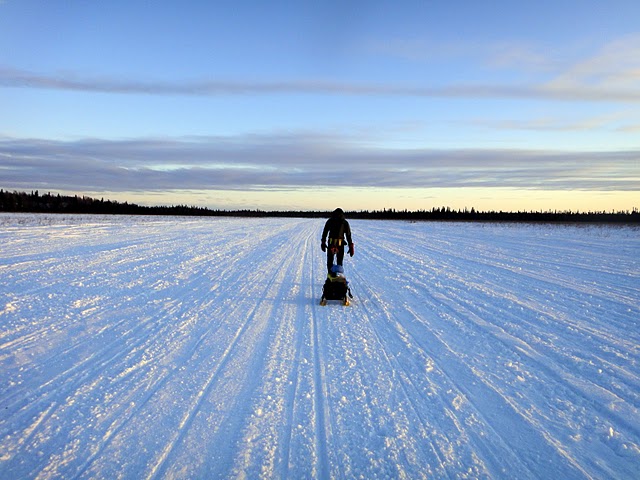 The endless dismal swamp. I think. The dismal swamp had some better footing, but still the overall resistance was high, and even without any climbing we could not really afford to muster more than a slowish shuffle. Just around sunset, the wind picked up significantly, and with it came little biting daggers penetrating my exposed skin, and making their way into my layers. I layered on a heavier balaclava and shut my mitten shells. My eyes hurt from the wind, and Jill happened to mention that it is important to be very careful with the eyes to avoid frostbite. Some of her friends had acquired frostbite on their corneas, and I for one was not excited about that prospect. Fortunately I had acquired a clear ski mask and put it on immediately. Even with the mask, the air coming in through the vents was uncomfortable, but much more muted. Quite possibly Jill had saved me from some rather stupid mistake right there, and I was very thankful to have her around.
When we came to the wall of death – mile 28 out and 78 back, which seemed rather unimpressive being only about four or five yards high and moderately steep – though icy and in some years with overhanging steps – the bike leaders came towards us, a group of three, led by Jeff Oatley. I was impressed and excited, because it meant good trails had to be ahead, or so I thought. Jeff warned me of a stiff headwind ahead, and the group pushed on, and I ran down the wall, hooting a bit with fun. Jill was not so amused, especially since her sled lacked some of the side stability that mine had (thanks to carving skis), but she made it down easily. We turned onto the Susitna river, which seemed rather enormous. The trail was still no better, punchy and with high resistance. I did notice that although we punched into the snow a bit with regularity, the bike tracks were very shallow and one would almost never see a bike punching through. This meant that the good bike conditions did not necessarily translate into ideal running conditions. Ah well. More of the same. Still, it could have been much worse I presume.
While we made our way to “Scary Tree”, the turn-off from the Susitna onto the Yentna river, the temperature kept dropping and the wind kept increasing. Once we got onto the Yentna, we had a very stiff headwind, which now penetrated our windstopper tights and cooled us down significantly. The only reason we got this far with our clothing were totally windproof high gaiters and our gore-tex shells, but my feet, which had been toasty all the way, started to cool, an I was alarmed. Jill said she needed to pee and put on a jacket at some point, and it was dark enough we really needed to put on our headlamps, and I suggested to just take care of business, and try to eat something as well. One thing about the cold is that it is very unpleasant to do stuff like take out your camelback hose (which was perfectly fine, not frozen, but required me to unzip my jacket, which I was unwilling to do, or take off my now seriously beloved mitten shells!). Jill stopped to do her stuff, and I took the opportunity to look around for some items like my pants which I couldn’t find, so I just grabbed some food and more headlayers as well as a heat pack which I simply dropped between my two baselayers on my chest, and another one for my hands, when I heard Jill struggle with her jacket. “I can’t use my hands! These zippers are so fidgety!” There was some panic in her voice, but I felt I had some warmth resources, and zipped myself up and put on my liner gloves and helped her out of her shell, into her down jacket, and back into her shell. Despite the gloves, my fingers started hurting severely, but the crisis was averted, with me feeling mildly proud for helping the infamous cold-weather Jill out! Only later did she tell me just how panicked she had been in this situation, because with a windchill in the -40 range, with a cooled core, one is very close to being in some real trouble. At that point I also realized that my system of a stuff-sack compressed sleeping bag would probably induce some extremely anxious moments should I actually need it in such a situation … because it needed strength to unpack. And that’s something that’s very hard to come by, when your hands are numb and frozen.
We carried on, I ate a tiny bit, but soon we just focused on working our way across the river. I noticed we could no longer see the trail markers, but Jill assured me it’s impossible to get lost. Still, the trail was much softer and punchier than before, and we worked quite hard. I figured the real trail would be on the other side, just about 200 yards away, and hopefully in better shape. I started making my way across, just to find that as soon as I stepped off the main trails I would be shin to knee deep in snow! So we carried on for another mile until I found a suitable passage, and indeed the trail was much better on the other side, the best conditions we would find in the whole race.
My legs started to get very cold, and I kept getting colder and colder and knew I had to do something. I stopped and told Jill to keep moving, which was courteous but maybe not the smart choice, which I realized very soon. I unpacked my primaloft jacket and unzipped my shell and almost lost it to the wind. Putting on the jacket was difficult, the arms just weren’t in the right place, and by the time I had it finally zipped up I was even colder. Putting on the shell was equally tedious, and I could barely get the main zipper up. Finally I had everything back together, just barely avoiding the same panicked situation that Jill had found herself in just a bit earlier, but with her long gone! I felt stupid, and pushed on. The one thing that makes winter ultras so much more extreme than anything else is that if you do what you feel like, namely just stand still and rest – you actually hurt yourself. Do it for a minute (without putting on tons of clothes), you’ll be cold. Do it for five, and you might not be able to go on. It’s more unforgiving than anything I’ve ever experienced.
I must not have had any water in hours, and trying to increase the pace and catch up with Jill I started to feel very ill and weak. The Jacket provided enough warmth to feel that I wasn’t in any danger of hypothermia though my legs were painfully cold, but my sled seemed to get heavier and heavier, and each step became very labored, my back hurting badly from the heavy load. I pushed and pushed, getting sicker, knowing the aid station was just two or so miles ahead. Weird thoughts pondering where I could place the footwarmers I had ran through my mind. I hoped to catch up to Jill, but nothing … until I finally saw a light. However that turned out to be another runner who decided it’s time to put on some layers … I think I passed two or three runners before I finally, just before Luce’s, caught up with Jill. During that time I so wanted to stop and just rest a little, but I was scared to death to stop moving. I admit there was a small twinge of being hurt because she had not waited for me, though I knew that she could not really afford to stand still for any period of time, and I quickly overcame the feeling (and after all I sent her away!). I was extremely glad to see Luce’s, though the 100 ft climb to the actual lodge seemed extremely difficult to me. I felt like I was going to hurl and pass out any minute, and stumbled into the station, barely able to initial my name. I dropped in front of the oven, and saw Steve and Jamshid who recommended for me to go to the Sauna to warm up. The thought seemed rather ridiculous to me, but over time I kept feeling very chilled, while all my stuff dried out at the hot stove heating the main room. Finally, after sitting and resting for what seemed like an eternity and after choking down some spaghetti an diet pepsis, slowly letting my nausea subside and regaining some strength, I decided to try the sauna, still feeling very cold. Stiffly, with aching back and feet,walked there and within a few minutes felt warmed up to the level of starting to perspire a little. I went outside to find I was no longer chilled – best sauna ever.
Ready to finally get going, and feeling guilty for holding Jill up for almost 2 hours despite me supposedly guiding her through her running experience or so, I got my stuff together. Jill told me she would put on just about everything she brought, and although I had felt almost warm with my puff jacket, I decided to put on two additional leg layers (fleece and shell), the big RBH mitten liners with the hand warmer and more head layers. With renewed energy, I was ready to make the stint to Alexander Lake, and then be on my way back!
I have a strange relationship with the HURT. It’s consistently been one of the most painful and hard to finish races for me – where even with a “normal” run I do >32 hours (in comparison, I got really sick at Wasatch and did horrible and finished in 30:48 …). The course eats your feet, beats them with bamboo poles, cooks you, sticks knifes in your quads and leaves you spent and aching long after you’ve kissed the finish sign. That’s when conditions are good … and they go bad quite easily, just add a bit of rain … Still, the worse the conditions are, the better I seem to be doing … maybe because I’m too stupid to give up. I just forget quitting. Or so I figure. Nevertheless I love this race – it’s an incredibly beautiful course unlike anything else I’ve seen, a very small and fun community of runners, regulars and crazy newbies, extremely well organized by people who know what they’re doing but still have a ton of fun along the way.
This year I went back to get my 500 mile jacket – the last year said jacket is given out. Jeff Huff sent all the potential candidates an e-mail saying we’d have to finish so he wouldn’t be stuck with leftovers. It was also the first hundred since I started seeing Jill, and I was nervous. Most of my recent training history focused on running in snow and cold temperatures, postholing, snowshoeing or snowbiking. Not exactly HURT training … Indeed even my heat training consisted of just about 5 visits to the sauna. I honestly had doubts if I still had what it took – both training wise as well as mentally – to finish this thing. Having been credited with 462 miles, I would get the jacket after only 67 miles … and I could just have a nice vacation with Jill. What WAS the point of doing this race yet again? But at least Jill was going to pace me for 20 miles, and that was something to look forward to – and although I knew Jill would be fully supportive if I were to quit, she was really looking forward to spending time on the trail and see me finish this. Although she’s been at HURT before – ironically I was there that same year as well, but we both were in a different life back then – she had never seen the course …
So Jill and I met at the Honolulu Airport – the strangest thing to meet at an Airport in a far away place when you already live far away. Hotel, race meeting, catching up with more friends than I ever meet in the bay area at once, grocery shopping … Friday was uneventful, we had some grocery store sushi and random food for dinner, and despite my being rather nervous we managed to go to bed early. It had rained all week, but the people who marked the course said the trails weren’t muddy. They were right … but that was only one third of the story, as I would find out the next day.
We got up at 4am on race morning, groggy and tired despite a good amount of sleep, went to the race start and waited. I got in the far back of the start line, Jill gave me a good luck kiss and off we went. I caught up to Monica Scholtz and started telling her about TDG, how I met Jill and so on, which was a great way to spend the time while slowly making our way up Hogsback. The trail was not muddy, but seemed still slippery, which isn’t totally unusual since HURT often gets somewhat slick in the night, with dew settling on the rocks and roots. I pulled away and started overtaking people until I caught up with Alex, my long-time HURT buddy. During that first section two things became apparent to me: I was slow. And the rocks on the trail were slippery (and there are a lot of rocks)! And I don’t mean a little bit slippery. I mean you walk slowly and still can’t find any traction kind of slippery. The rocks were covered with a thin film of slimy lubricant which made everything seem rather treacherous. In addition, it felt like a sauna – incredibly humid at 92%, making even the seemingly moderate temperatures hard to bear. I started sweating profusely within the first 20 minutes, prompting me to consume large amounts of nuun. In the end I was probably still over-hydrated, but the night usually rectifies issues like that for me.
The first loop was hard – much harder than I remembered any first loop being. And slow – with ~5:20, far beyond my usual pace. I felt tired and worn down when I got back to Nature Center, where I met Jill for the first time since the race start. “I don’t know how far I’ll get. I’m tired. It’s really slick and slippery.” I told Jill. She smiled and said “Just see how far you get.”. She’s been helping my mom trying to sign me up for TDG again – the entry opened at 9am that morning. I couldn’t believe I was having them do this, given my performance it seemed just so outlandish. I didn’t feel like earting much during the whole race, and my calories were split about evenly between sodas and candy – not exactly a solid nutritional foundation for a hundred, but I’ve long given up battling my stubborn digestive system …
The second loop felt actually much better than the first – the shock of the bad conditions had subsided and was replaced by acceptance – still the day did nothing to alleviate the slickness of the course, it just made things a lot warmer. I finished the second loop after about 11:20, which was acceptable, though I had already started to do the math in my head about if I could finish. And I was worried about Jill, because the trail conditions were quite dangerous. After the second loop, the RD John told me he had a pacer if I wanted, a 16-year aspiring ultrarunner, and I simply could not say no. The third loop started at dawn, and I reached the Paradise aid station in the dark. At HURT, the night slows you down but reveals the strangest views of a little bubble of jungle lit up by your lamp, waterfalls and cliffs just at the edge of your lights, and views of night-time Honolulu creating a very strange contrast. I was tired and contemplated dropping and my chances to finish, but at the same time I was looking forward to getting Jill out here, feeling excitement like a little kid about to show his best friend his cool secret treehouse. My pacer turned out to be a very cool kid, quiet but genuinely enjoying being on the trails. He wants to run HURT 100 next year, and I told him some of my war stories and gave him some fatherly ultra-advice. I am sure he can do really well on the course.
When I got to the end of the third loop I was very happy to finally hook up with Jill, but at the same time I was also rather baked. Loop 4 is usually my slowest loop, tedious, the advanced tiredness making me tentative and slow in the dark, but also filled with cool night views, and usually a killer sunrise. I still couldn’t eat much but got down some soup, my stomach was growling emptily and angrily at me. I fought some minor nausea but overall I was lucky since everything seemed to be holding together well enough. Doing the loop with Jill was very exciting, and I proudly showed off the awesome course features to her, looking particularly forward to present the incredible manoa flats root nightmare and the rope sections on the descent to jackass ginger. Jill seemed duly impressed – then on the final leg of the loop the sun came up and revealed the incredibly lush and steep mountain scenery. Despite all my times running HURT there were a lot of new beautiful features I discovered, probably because I paid much more attention to finding good photo opportunities for Jill! We talked about her running the first part of loop 5 with me as well, which, to my delight, she agreed to. Toward the end of loop 4 it became apparent that I had been moving very slowly – the loop would be an 8.5 hour loop, getting us to the beginning of loop 5 with just 10 1/2 hours until the cut-off – certainly doable but by means of extrapolation very disconcerting, keeping me quiet and worried.
I significantly picked up the pace on loop 5 – both because it was light as well as because I was very scared. We did the first section faster than I expected, and I was optimistic. To my surprise, I passed Alex on the downhill – he has foot issues and seemed a bit down – and he just said “Beat got the Jesus fire. Happens every time.”. Fueled by such spiritual energy I was determined to make good time. Despite the prospect of time-based DNF diminishing, the urgency from my worry stayed high, and I pushed forward. I overtook a handful of people who were probably having some faith issues or so and thus being depleted and tired. On the last section, my feet started hurting like crazy – probably some vitamin I that wore off – but I decided to simply ignore it and go on. Some of the final downhill was fairly treacherous anyways, and I did not feel like putting Susitna at risk to gain a few minutes. The whole last loop I played a game in my head – the “I never have to see this trail again [in this direction]” game. And with my 500 mile jacket secured, I really didn’t. I ended up doing a ~7 hour loop, which was a pleasant surprise.
When I ran into the finish I found Jill waiting for me with a big kiss and hug, all smiles and cheerful – she had ended up being the perfect crew person and pacer for me, and she had added hugely to my HURT experience. To my great surprise I found I was – with a finishing time of 33:31 – only the 13th finisher, despite being so far back in the pack. The finisher rate ended up being about 28% – due to a few falls, a broken ankle and people just being exhausted from the heat. Alex came in just a few minutes behind me, recovered from his foot issues. As usual, the pain would linger, but I was very well distracted, and the following day Jill and I went for a power-hike/run from our hotel to Diamond Head. I got my 500 mile jacket, and all was good. I really didn’t have to go back. I was part of the 500 mile club now! Until I saw that Monica was alone in the 1000-mile club. Hmmmmm …
If you want to see pictures, head over to see Jill’s posts about the race here and here.
2010 has been such an extraordinary year for me, I decided to write it up (also I have some me-too going on because of Jill’s year-review post(s), but of course I have barely any pictures and can’t write too good, so don’t expect much). Here we go (and yes, I completely shamelessly stole the format from Jill):
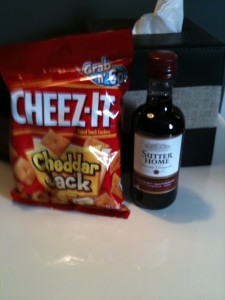 Wine and Cheese January, “Wine and Cheese”: The new year started out slow. Both me and my ex realized our relationship had been over for a while and acknowledged it, and I finally decided to move back closer to work, cutting my commute from 2 hours a day to 20-30 minutes. Overall, I was sort of aimless and in a sort of bad mood, which was fittingly confirmed by my earning the Wine and Cheese award at the 2010 HURT.
 Tilden Park Berkeley February, “Back to the start”: In February, I finally decided to move back to Los Altos, almost to the same place I lived in for a few years before my stint in Berkeley. I missed the steep hills and excellent views of San Francisco and the North Bay from the Berkeley Hills, but I definitely did NOT miss the horrible east bay commute with its crazy drivers. Still, it felt like my life had come to a full circle with no progress, and I hesitated to even unpack my boxes. Apart from my racing, which I loved, everything else in my life seems to have stood still for the last couple of years, with no real prospect of any change.
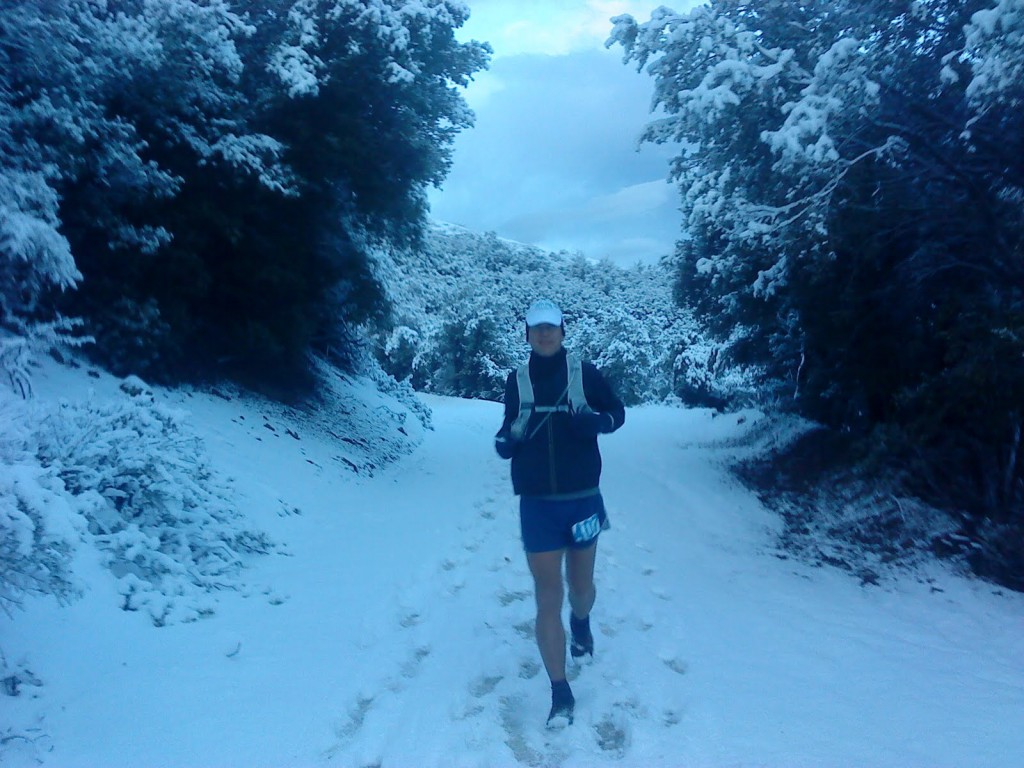 Fun at C2M March, “Shiny and new”: March was the turning point of the year. Just because as a software engineer you have to interview with Google at least once I had given that a try earlier in the year, but didn’t expect anything to come out of it, much less anything that I would want. To my surprise though, Google made a good offer and I took the opportunity to change and see one of the most unique companies in the world from the inside – and I haven’t looked back. To this day, this is clearly my best job (at least my best “real” job) – crazy smart people, great leaders, great work environment.
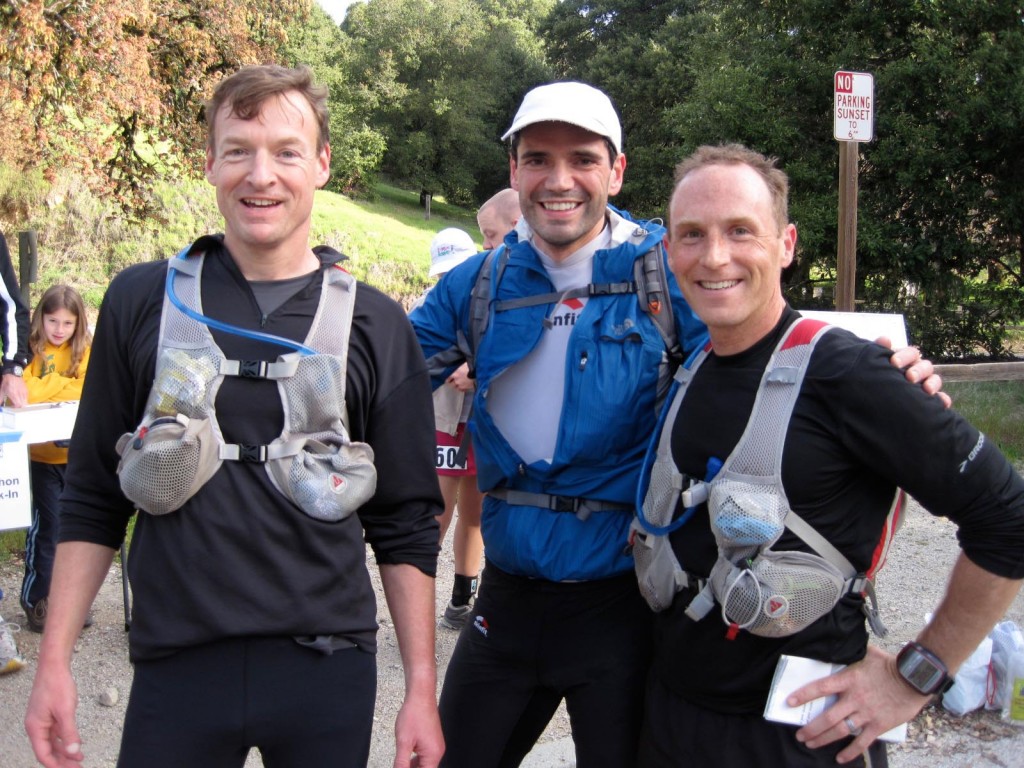 Harry, Me, Steve in the middle of our little 100k adventure. April, “Friends”: April continued the positive trend as I became much better friends with Heather, Martina, Harry and Steve, spending lots of training runs together, leading to our own little 100k race, which was a ~50k run from my apartment to the start of the Skyline To The Sea 50k, leaving at 1:30am from my place. We got the the official start with about 30 minutes to spare. I was surprised to find myself in my usual spot for the first few miles, only to bonk quite badly afterwards, the price you pay for trying to keep up with fresh legs. At least I was able to answer the question “Is this your first 50k?” with “No it’s my second. Today.”.
May, “Old”: I honestly don’t have any pictures from May, and there wasn’t much going on, really. I turned 41, which means I was now really really quite old, and sure enough stuff started hurting.
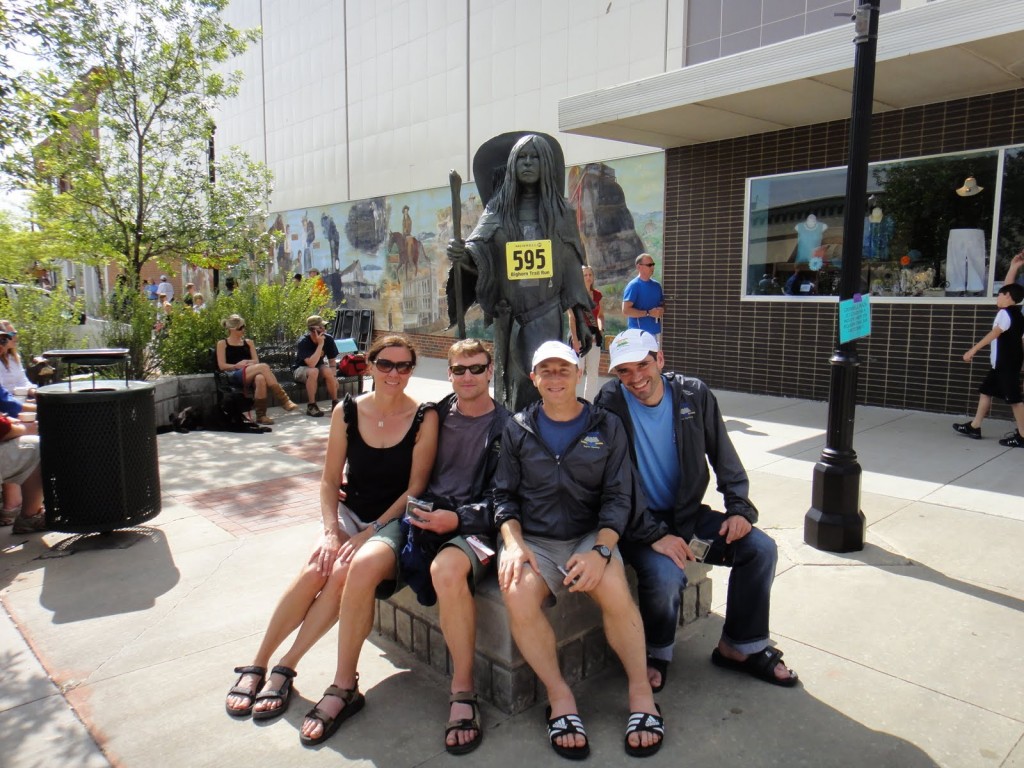 Martina, Harry, Steve, Me at the Bighorn award ceremony June, “Racing”: June held a hectic schedule – I ran Diablo 50k (with ~9000ft climbing in brutal heat), starting very early at ~6am so I could catch a flight to Switzerland later the same day, did the Biel 100k road race with my friend Chris Marolf the weekend after right before flying back, just to head out to run Bighorn with my south bay friends the following weekend. Despite the tight schedule things went surprisingly well. I also ran many miles with a fun gal named Leslie, who, amongst many other things, told me about a crazy friend of hers doing a crazy mountain bike race from Canada to the Mexican border. She in turn introduced me to Danni, who was one of the RDs for Swan Crest which I intended to run later. If my life seems to be centered around running races at this time it is because that’s exactly what my life was – work and run (mostly in form of racing). Not much else.
 Steve snaps a flattering picture of me trying to navigate a debris field. July, “Dumb Luck”: Swan Crest almost did not happen for me. First I wanted to run Fat Dog in Canada, but Swan Crest had much more climbing so I switched to that since I felt I had to train for Tor Des Geants. Then some pseudo-environmentalist douchebag almost had Swan Crest cancelled, but last minute the RDs decided to run it as a not-for-profit event. Swan Crest itself was an interesting experience, but of course the highlight of the run was meeting Jill at the finish.
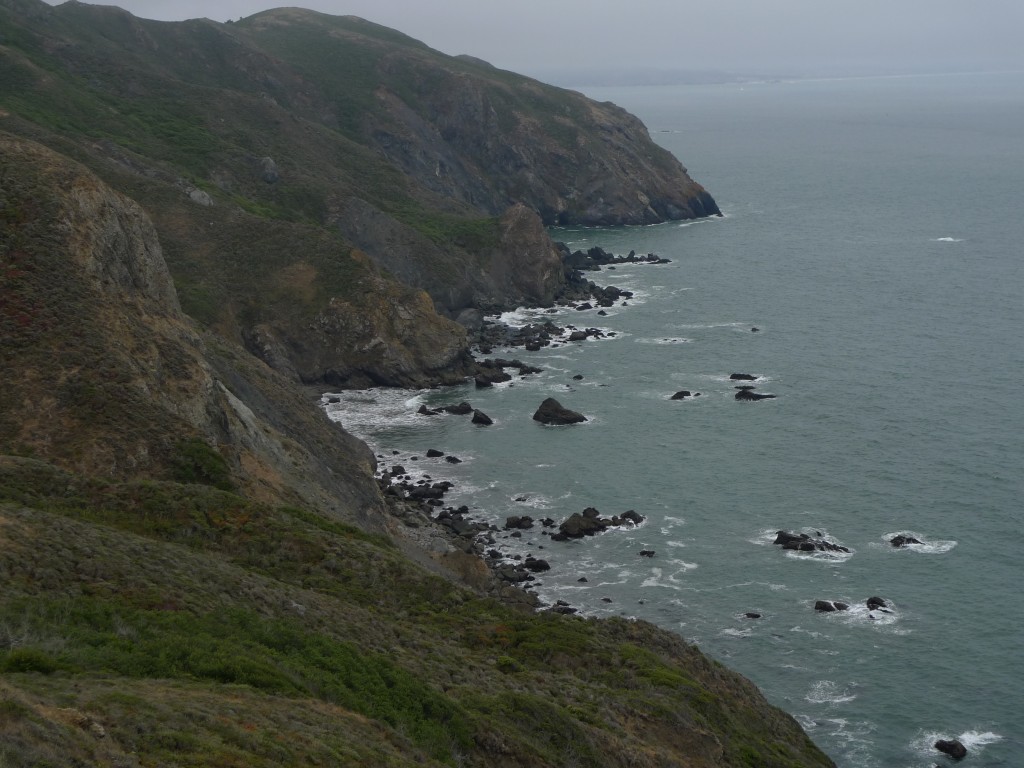 Pirate's Cove during Headlands 100 August, “Possibilities”: This was maybe the second-most intense month of my life, only because September would beat it. Jill and I struck up an intense Facebook friendship, and things went quickly from “Montana – impossible. But that chick is cool.” to “I have to meet Jill in person and ask her out or I’ll forever regret it”. At the same time, several friendships deepened significantly. Racing wise, I did Headlands just a week after Swan Crest in a childish but successful attempt to impress Jill and went for a completely surreal 51k road ultra in the Nevada desert near Area 51 with Steve. However all this foolishness left me with some lingering overuse injuries that made me wonder if I would get far in the Tor Des Geants.
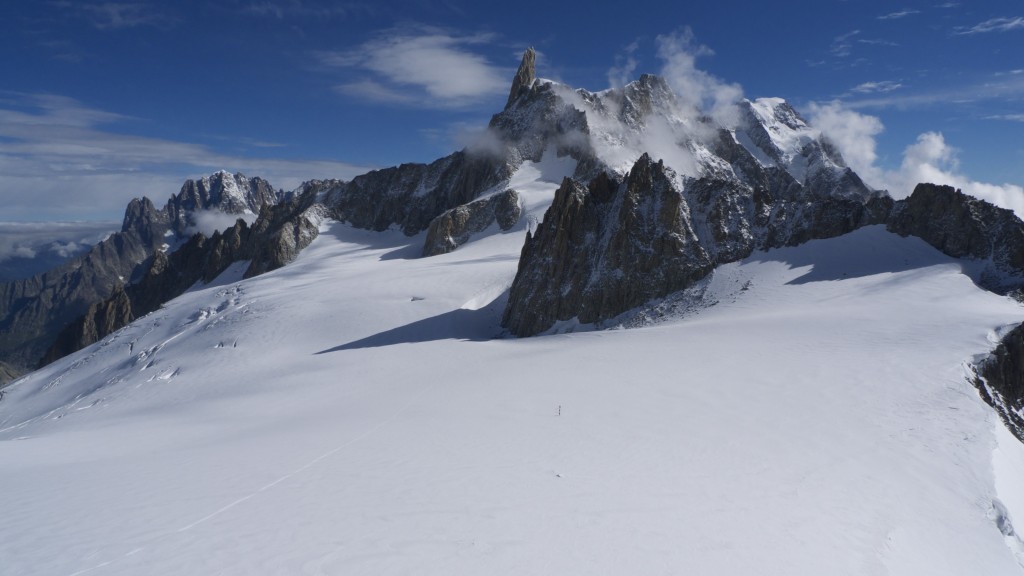 The "tooth of the giant", which gives the Tor Des Geants its name. September: There isn’t really one key phrase to describe this month, which is the most intense month of my entire life (so far). It contained the most intense race/physical effort I have done – 200+ miles, 80000ft of climbing, 132 hours, 4 1/2 hours of sleep – most of which I thought about Jill and my plans to meet her. This was followed by the most crazy, risky, stupid and brilliant plan that lead to the most romantic and challenging first date ever – Jill pacing me for 50 miles at the Bear a mere week after finishing Tor Des Geants – her not having ran more than a few miles ever, me being completely obliterated from TDG. To this day I wonder how this all just turned out so perfectly, but it’s the month where my life went from “so-so” to “extraordinarily great”.
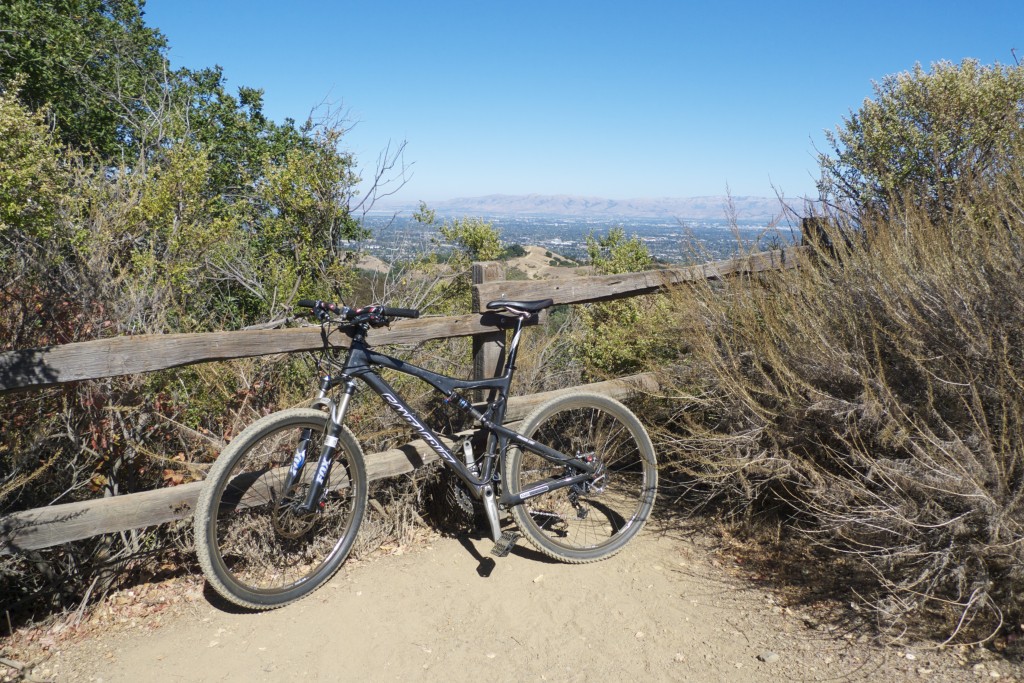 My first mountain bike ride in California ... October “Bridge“: When Jill and I were running the Bear in the night, we mentioned the issue of distance. I called it a “minor complication”. Now here I was, dating my dream woman … 1100 miles away. The month was all about finding out just how minor this complication was … and it turned out to be not so bad, thanks to uber-cool bosses and a solid financial situation, and things just kept getting better and surprising me positively. This month I learned a host of new things: how to pack and travel efficiently, mountain bike at night, what a bike shuttle and a personal man-slave is, and did my first overnight backpacking trip. I got a mountain bike back home as well … a new world full of possibilities!
 Perfect day November “Snow”: Going into November, things kept getting better, more fun and more exciting. My first mountain bike race, snowshoe excursion, snowbike ride, visit to Canada … it was a year in one month! Intense. Insane. Super-awesome.
 Once you go fat, you never go back ... December “Happy“: You can’t resist fatbikes … as is well known. I just had to get one. Also I am signed up for a 100 mile snow bike race in Alaska. More fun adventures ensued, things still kept getting better … looking back I have to shake my head at the lucky string of events that got me here, a lot of crazy decisions (starting with signing up for TDG, leading me to picking the hardest races to train, rejoining Facebook, doing the Bear, starting a very very long distance relationship with poor flight connections …), and think back at what Stevie Haston told me when we were running together for a few hours at the TDG: A faint heart never won a fair lady (french proverb). I think I did quite well.
Stats: Some fun stats for my year …
- miles raced on foot: ~1231
(7x50k, 1x51k, 1x50m, 2x100k, 6x100m, 1x208m)
- feet climbed in foot races: ~283000
- hours raced on foot: 400 and 32 minutes
- Trips to Europe: 2
- Trips to see Jill: ~12
- New bikes: 2
- New activities: 5 (snow biking, mountain bike racing, snowshoeing, backpacking, bike shuttling)
The last mile of Swan Crest … it was miserably hot, I thought I was gonna pass out from a heatstroke, and I walked very slowly towards the finish line. No one was behind me, so I wasn’t in a hurry … my spirit was gone, and I simply lacked any mental energy to get myself to speed up. Usually I put in at least a few hundred yards of finish sprint in … I think I mustered ten. But as soon as I was at the finish, I was grinning, talking smack and generally happy – it’s the one thing I’m pretty good at: pretending it never happened. Good so, because it caught the attention of Jill (who I noticed immediately but I thought was too cute to be interested in me) who struck up a conversation after Danni introduced us. Very quickly it came up that Jill had done the Tour Divide – and suddenly a lot of clicks happened in my head – earlier at Bighorn I ran with Leslie (who is a good friend of Jill’s) who told me about the Tour Divide, this crazy mystical race that only insane ultra-athletes can even begin to understand, and only the hardest-core thereof can finish, and a friend of hers who had done it (Jill, of course). I was immediately star-struck … when Jill expressed interest in running 100 milers, I scoffed – “You could do one tomorrow!”. I scoffed because I know people – especially myself – with a fraction of her prowess who can do it. I even went so far to try to talk her into doing one the following week (and I still think she could have done that …). And I didn’t even realize she holds the woman’s course record on the Tour Divide until much later!
Since then I’ve had the privilege to see her up close, and I have to say she’s even more impressive than I thought. But then I became somewhat suspicious – how could this be real? Let’s look at the facts I gathered during her short run training. I think of myself as a somewhat accomplished endurance runner at least in terms of finishing stuff, so I’ll contrast my own experiences:
|
Beat |
Jill |
| Complaining |
Wine & Cheese award at HURT |
Never. Ever |
| Rest day |
Maybe an hour on the trainer |
I got lost and ended up running 4 hours. Felt great though. |
| Weekly average |
10 hours |
20 hours |
| First ultra run |
See below |
50 miles on NO training. Minor foot problem that quickly disappears |
| First ultra race (50k) |
well trained, 7:15, unable to walk the next day |
3 weeks of some run-training, 6:58, no soreness |
| Time between first ultrarun and first 100m |
10+ months |
2 months |
| General endurance |
Gets tired after 4 hours |
Warms up after 4 hours |
| Temerature sensitivity |
Gets slow in heat and cold |
Claims doesn’t like heat, but unable to prove it |
| Final thoughts in a race |
Thank god its over. Where’s the bed? |
Sniff. It’s over already??? |
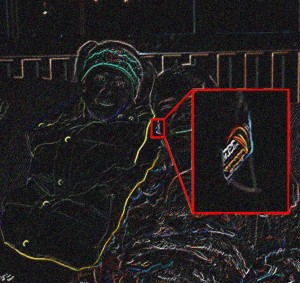 Fig. 1: Jill the energizer bunny! The list could go on and on. Jill is really sort of superhuman in a rather suspicious way. I checked back on some pictures of her “ski bunny” outfit and analyzed it with a novel technique that can detect residual electroweak interference patterns even in JPEG-processed digital camera pictures, which is an effect of latent quantum entanglement. Using advanced image processing techniques I found a shocking revelation, as seen in Fig. 1. I was able to identify the battery as a lithium one (ironically she seems to be using Energizer batteries)., which explains perfectly Jill’s cold-resistance and extreme endurance. Everything suddenly makes sense, her strange affinity for “bunny” costumes, her preference to be alone during restroom breaks, her perking up during exercise and of course her superhuman endurance.
On a more serious note, it needs to be said that I am not exaggerating Jill’s extreme endurance – she is simply impossible to keep up with. She challenges herself constantly. And beyond the pure endurance part I found her to be one of the most successful people I’ve ever met – although she loves to write about her occasional mishaps and unpreparedness – in the end she actually has everything under control, knows what she wants and succeeds in almost everything she sets out to do, and lives her life with a clarity and purpose that I have rarely seen in my life. She really is much more awesome than her blog conveys – and all of this while being the most down to earth, nice, beautiful and intelligent person you could imagine. Which makes me the luckiest bastard in the world. Yeah!
So I have a backlog of blog posts I want to write. There’s the TDG report, the Bear report and a post about why Jill is so extremely awesome. One day I’ll do those. Until then, here’s my plan of 2011 races:
January: HURT – Going back for my 500 mile jacket. I only have to finish the 100k to get there, but of course I’m aiming for 100m …
February: Susitna – I am seriously scared. Cold weather is more of a challenge than I thought. Jill will be doing her first foot 100, and I really hope we can stick it out together … but if one of us can’t stay warm we might not be able to wait for each other. It’ll be fun either way. However, this isn’t even as cold as …
March: White Mountains – My first 100 mile bike race. I just got my Fatback – it’s sitting in Jill’s apartment and she’ll ride it before me. Her race report scares me to death. -20F is to be expected for sure. And on the bike it’s much harder to keep your feet and hands warm.
June: San Diego or Bighorn? – I do need to put in a number of 100s for TDG. San Diego is the quick and easy choice, Bighorn beautiful. Bighorn could be a good 50 miler for Jill 🙂
July: Hardrock (tentative/pending lottery) – would be tricky to swing the acclimation. But if I were to get in. Hmmm.
July: Swan Crest – Jill’s still interested in that one, and I’d be happy to oblige 🙂
August: Capitol Forest 100 – a mountain bike 100 set up by my friend Roger. Looks super fun.
September: TDG – Yes, I would love to do this again. This time though I won’t be dreaming of meeting Jill, I’ll be going with her … we might hike the UTMB course the week before the race, or try to climb Mont Blanc if our mountaineering skills are sufficient, or both.
November: Racing The Planet Nepal – Nuff said. Jill’s going, too.
|
|

